In this article, we’ll cover everything you need to know about visiting the ancient city of Petra. What are the best sights to see in Petra, how to best tour Petra, where to eat and everything else to plan a great trip to Petra in Jordan.
No visit to Jordan would be complete without a stop in the Ancient City of Petra.
Petra is one of the Seven Wonders of the Modern World. It’s roughly 2,000 years old. And it’s one of the highlights in Jordan.
Whether you’re visiting Jordan for 7 days, or 2 weeks, or longer, you need to add Petra to your itinerary. It’s as simple as that!
Often referred to as the “Rose City”, Petra is an ancient archaeological site nestled in the rugged desert canyons of southern Jordan. It’s also called the Ancient City of Petra since there is evidence of settlement in the area as far back as the Neolithic period (4,000 to 12,000 years ago).
There is so much to learn about this amazing place. And that’s why we wrote this comprehensive guide to Petra for you.
If this is your first time in Jordan and your first visit to Petra, we’re hoping to tell you everything you need to know about this place. These are all the things we wished we had known before visiting Petra, and then some.
Take your time and read this Petra travel guide. We’ll give you as many details as possible. If you choose to go without a guide, like we did, we’re hoping this article will tell you more about this incredible place!
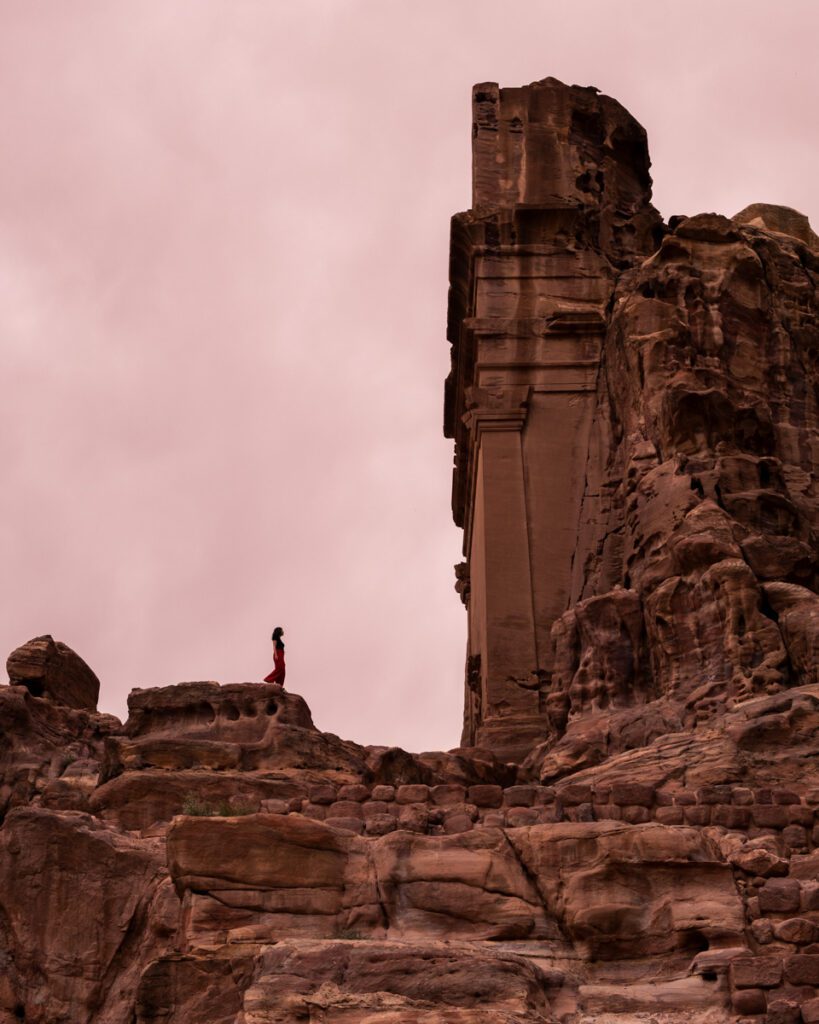
This article may contain affiliate/compensated links. For more information, please see our disclaimer here. We take all the efforts necessary to ensure the information included in this post is accurate, correct and current, sometimes, things just change! Travel information like opening hours, business operations and prices may change. If you find anything in this post that is incorrect or outdated, please let me know in the comments so I can update it for other readers. Cheers!
We love helping you plan amazing trips. If you need any of these services, consider booking them through our affiliate links. Without costing you anything extra, you will be helping support us so we can continue to write these blogs for you.
We thank you again for your continued support.
🏠 Find the perfect place to stay with Booking.com
✈️ Get the cheapest flights with Skyscanner
🚣 Book your favorite activities with Viator
💻 Make sure you have everything you need for your epic trip by checking our store on Amazon
Table of Contents
A quick history of the Ancient City of Petra
Often referred to as the “Rose City”, Petra is an ancient archaeological site. It’s located in the southern part of Jordan, nestled in the rugged desert canyons.
The history of Petra dates back over 2,000 years, although its actual original build date is unknown. There’s evidence of settlement in the area that dates back to the Neolithic period. But that is before Petra was important.
In fact, Petra rose to prominence as the capital of the Nabatean Kingdom around the 4th century BCE.
The Nabateans are an ancient people. They were skilled traders and builders. Proof of those skills are all over the Ancient City of Petra with the carved temples, tombs, and dwellings. You can find them all over the rose sandstone cliffs. It’s crazy to think what this city was like in its heyday. Just walking around today, you can imagine the bustling cityscape that flourished as a hub of commerce along these ancient trade routes.
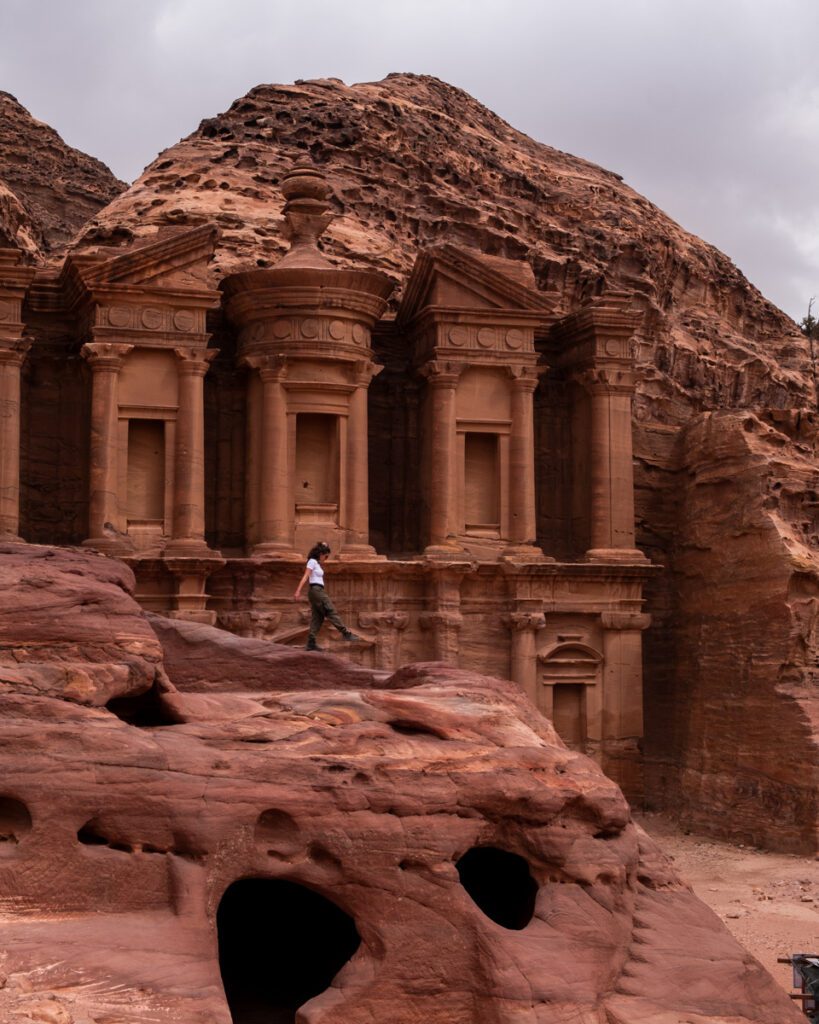
Petra served as a crossroads for trade caravans traveling between Arabia, Egypt, and the Mediterranean. Petra became most prominent during the 1st century CE, under the rule of King Aretas IV, who expanded the Ancient City’s architectural splendor and solidified its status as a cultural and economic powerhouse.
However, with the rise of the Roman Empire, Petra’s power diminished since many of the trade routes shifted away from the region. Petra was then annexed to the Roman Empire but was still a bustling city.
However, its fate would change in 363 AD, as most of the city was destroyed during an earthquake. After that, the city would never recover.
By the 4th century CE, Petra had fallen into obscurity, abandoned by its inhabitants. Eventually, it was engulfed by the desert sands. Forgotten to the rest of the world.
The rediscovery of Petra
There’s a reason we call Petra “the Lost City”. After it was abandoned, Petra became a literal ghost town. No one knew it was there.
For centuries, Petra remained hidden from the Western world. It was only in 1812 that it was rediscovered by Swiss explorer Johann Ludwig Burckhardt. He dressed as an Arab and convinced his Bedouin guide to take him to the lost city. Can we call him the original Indiana Jones?
How crazy is that? Petra was forgotten for about 1,500 years!
Burckhardt’s accounts of Petra’s grandeur captured the imagination of the world. That’s when interest in Petra’s preservation and exploration began again.
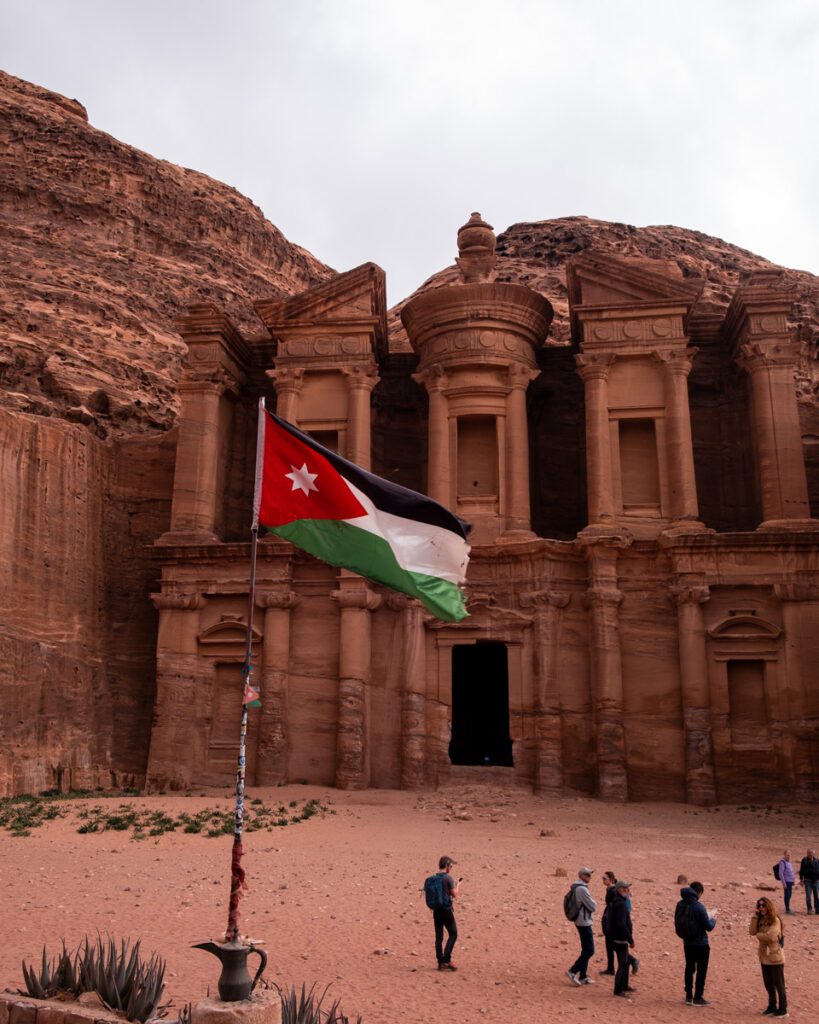
Through the 20th and 21st centuries, ongoing archaeological excavations and restoration efforts slowly unveiled Petra’s treasures to a global audience. Restoring this immense city was no small task, but this hard work allowed us to explore it today.
In 1985, Petra was recognized as a UNESCO World Heritage Site.
Today, Petra stands as one of the most iconic and visited archaeological sites in the world. It’s also considered to be one of the seven wonders of the Modern World.
Petra attracts travelers, scholars, and adventurers who come to marvel at its awe-inspiring architecture, rich history and enduring legacy. Discovering this immense site is a definite highlight of visiting Jordan.

Map of the best things to do in Petra
In order to get a full understanding of the size of Petra, here is a quick map that shows where everything is located.
When we say Petra is huge, this is what we mean. Although some of the sites are close together, some of the hidden gems are truly hidden and off-the-beaten-path.
This map will help you better plan how you want to spend your days in Petra.
The main highlights of Petra. Top attractions in the Ancient City of Petra
Now that you know a bit more about the history of the Rose City, let’s dive into the top attractions in Petra you can see when you’re visiting the site.
Know that the total site of the Ancient city of Petra extends over 264 square kilometers. If you can imagine what roughly 50,000 football fields look like, well that’s the area it covers.
And unlike what you usually see when you think of Petra, there is much more to the site than just the Treasury. Just getting to Al-Khazneh, aka the Treasury, is a 30-minute walk from the main entrance.
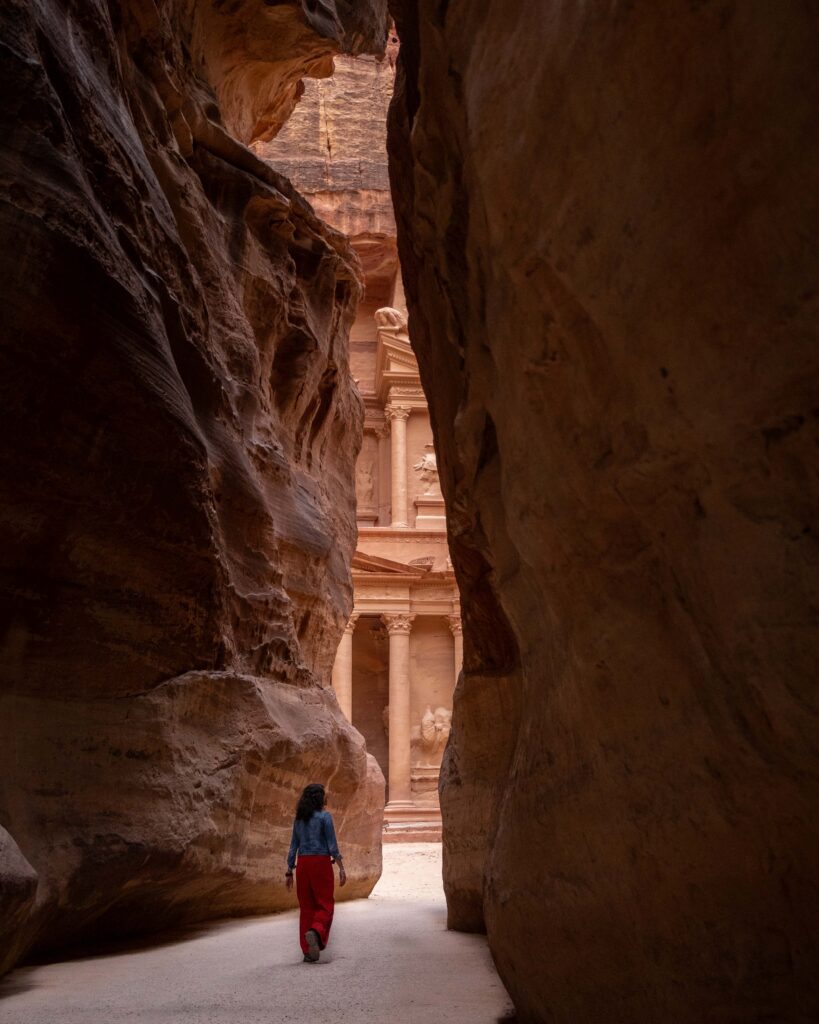
So get ready to walk a lot (and read a lot) as there are plenty of sights in Petra that are worth visiting. Depending on how many days you have, and how keen you are on walking, you can determine your itinerary and what you can see.
In this list, we’ll start with the most important and impressive structures and go down the list.
If you’re looking for the best things to do in Petra, including top attractions, hidden gems and the best hiking trails, check out our guide here.
1. Discover the Treasury, the top attraction in Petra
Did you even visit Petra if you didn’t see the Treasury? Nope!
Arguably the most famous and iconic site in the Rose City, there’s a reason this is the main attraction in Petra that you always see pictures of. It’s really impressive to admire from all angles.
What also adds to the magic of the Treasury is how it pops up out of nowhere. You’ll come upon it as soon as the narrow Siq (canyon walls) opens up. You’ll get small glimpses of it, and all of a sudden, there it will be, in all its glory!
Al-Khazneh, or The Treasury, is considered to be Petra’s most beautiful facade. It stretches about 40 meters high, taking up most of the rock facade of the surrounding cliffs.
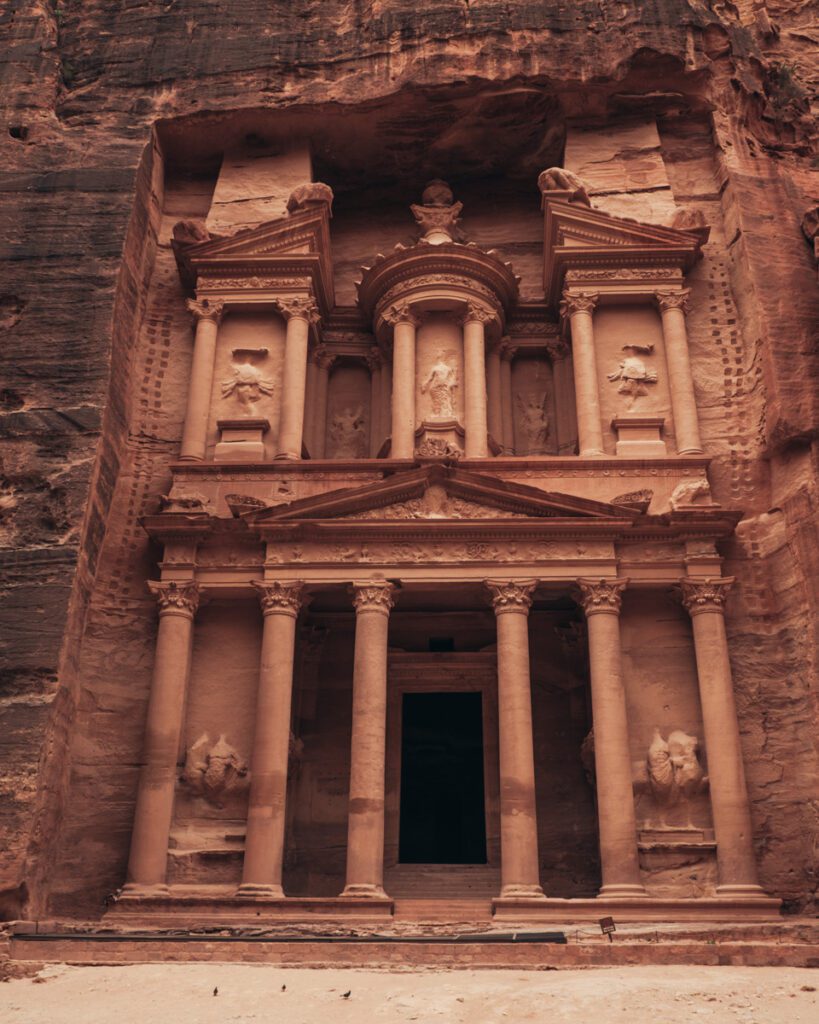
On the Treasury, you can see intricately carved columns, friezes, figures and lots more. At the top, the Treasury is crowned by a funerary urn. According to local legend, it conceals a pharaoh’s treasure.
But the truth is the Treasury’s exact purpose still remains a mystery. The leading theories say that it could be a royal tomb, a temple or an actual treasury…
Getting to the Treasury is not hard. It’s just a 30-minute walk from the main entrance. The ground is pretty flat with no elevation gain. And the route is paved.
If you don’t want to walk to the Treasury, you can take an electric golf cart or take a horse. We don’t recommend any of these options unless you are truly unable to walk there. We’ll get into the transportation modes in Petra later on.
2. Walk along the Siq, Petra’s narrow canyon
From the main entrance, the Siq is the narrow canyon you have to take to get to the Treasury and the rest of the attractions in Petra’s site.
The Siq is an impressive route that winds through the towering sandstone cliffs. It was created by the natural splitting of the mountain. It changes colors and shapes, and it leads you to the mysteries inside Petra’s Ancient City.
This passageway stretches over a kilometer (1.2 km to be exact). The walk through it lasts about 10-15 minutes and is super enjoyable. The surface is flat and well-paved. If there are no electric golf carts driving through it, you can hear the birds chipping and the echoes of people talking. It’s really a lovely experience.
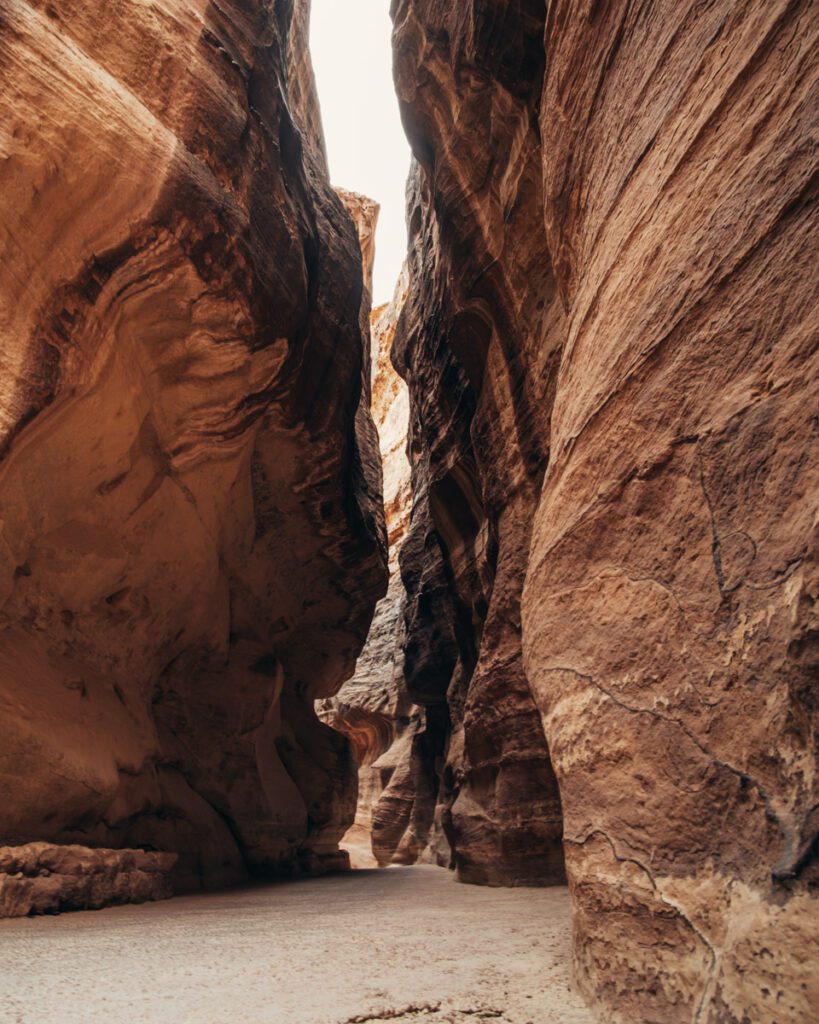
Beyond the sheer magnitude of the Siq, what makes it so impressive is that along the sides, you can see the water channels used by the Nabateans. These are remnants of their aqueduct system. After all, the Nabateans were known to be masters in hydrological engineering.
After a nice walk down the Siq, you will get to an opening where the Treasury will peak through. The rest of Petra’s sites will come after this.
3. The Monastery, hard to get to, but beautiful to admire
The Monastery, or Ad Deir, is one of the harder sites to get to within the main part of Petra. But it’s well worth visiting when you get there.
We walked Petra from the back way to get here and absolutely loved the experience. It’s a great hike for those who want to get off the beaten path in Petra!
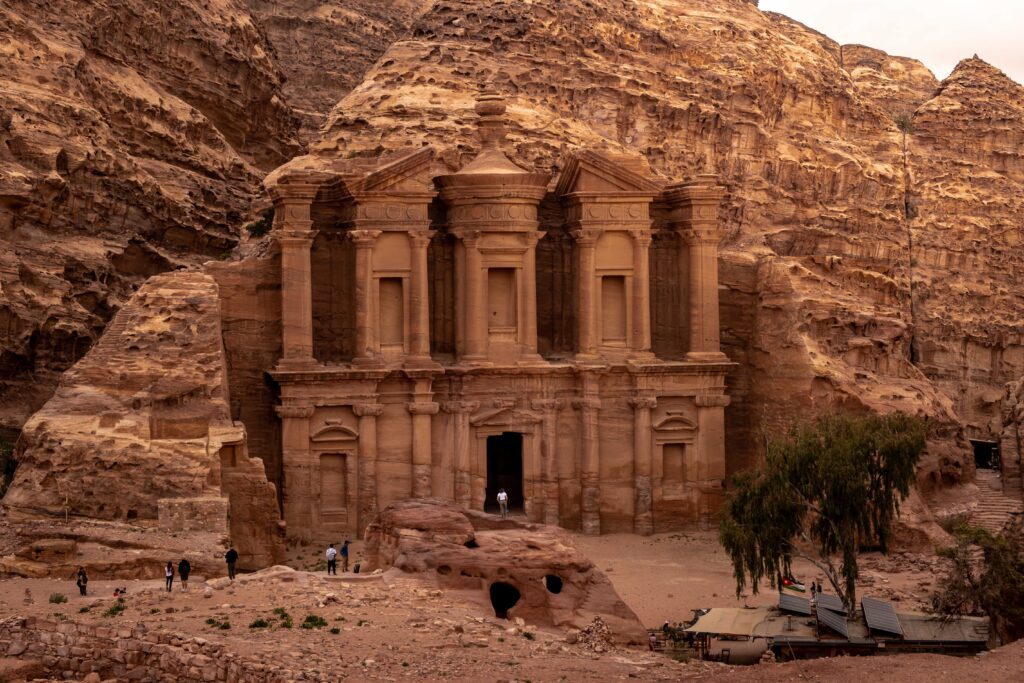
The Monastery is located high on the cliffs overlooking Petra. It has a similar design to the Treasury but it’s much larger in scale. In fact, the Monastery is the largest monument in Petra. It’s 47 meters wide and 48 meters high.
It used to be an important place within the city, as it was used as a religious meeting place. It features a massive facade adorned with columns, statues, and intricate reliefs.
The Monastery was said to be built in the 2nd century AD. Later, it was used by Christians as a chapel. Some crosses are carved into the rear wall of the main hall, which is where the structure got its name.
Top tip for visiting the Monastery:
There are 2 ways to get to the Monastery. If you try to get here from Petra’s main entrance, you’ll have to walk through the entire site, then climb up hundreds of steps to get to it. This route will take anywhere from 1.5-2 hours, depending on the sites you stop and see.The negative part about this hike is that you’ll have to double back once you reach the Monastery and hike the same route in the opposite direction.
Alternatively, you can take the free shuttle to Little Petra, and from there, take another Jeep (5 JOD per person) to the back stairs. You’ll need to hike a good 2 hours to reach the Monastery.
What we loved about this hike is that the views of the area were breathtaking. Also, you don’t need to rewalk the Petra site once you reach the Monastery. Plus, you don’t need to climb the stairs to the site. Instead, you’ll be heading down them.
Read more about this in our article about hiking Petra the back way
4. Little Petra, a hike worth doing in the Ancient City of Petra
Little Petra is known as Siq al-Barid. It’s a lesser-known and visited site a few kilometers away from the main entrance of Petra.
Although it’s not as big or grandiose as Petra, Little Petra is well worth visiting in its own right. It’s a charming site and it has historical significance when it comes to Petra.
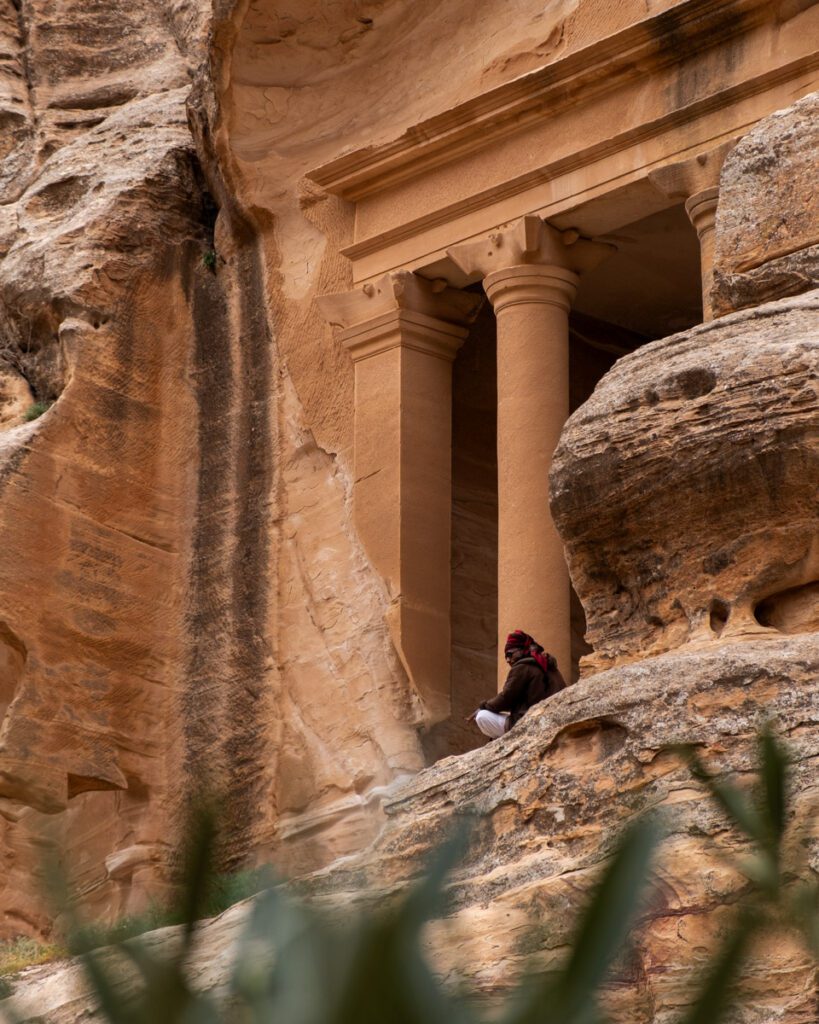
The best way to get to Little Petra is to take the free shuttle that runs every 30 min from 7:30 am to 2 pm. You can catch it behind the Petra Museum.
The shuttle doesn’t always run on time. In fact, they often wait until there are enough people on the bus to get going. We got there on time at 10 am and waited 15 min before leaving.
Our best tip is to sit on the driver’s side to get the best views. Although the ride is only 15 minutes long, it’s a beautiful journey. The shuttle will take you to the entrance of Little Petra. Know that this site is actually free to visit.
The highlights of Little Petra
You won’t need a ton of time to visit Little Petra – one hour is ample time.
Here, you can visit a few of the highlights:
- The architectural features: Like Petra, Little Petra has some impressive architecture that has been carved into the cliffs. Here, there are facades, chambers, and cisterns. And even if it’s on a smaller scale than Petra’s monumental structures, the buildings at Little Petra exhibit similar Nabatean craftsmanship and design elements.
- The Siq al-Barid: Just like Petra is accessed through the Siq, Little Petra has a similar narrow canyon. It’s known as the Siq al-Barid, or “Cold Canyon.” It’s not as dramatic as Petra’s Siq. But this canyon still offers a scenic approach to the site, with towering cliffs and intriguing rock formations.
- Painted frescoes: One of the unique features of Little Petra is the presence of painted frescoes adorning some of the interior walls of the rock-cut chambers. You can see some of them in the carved sections. However, with time, they are not very impressive to see today.
Although off the beaten track, Little Petra is a great site to visit if you have the time.
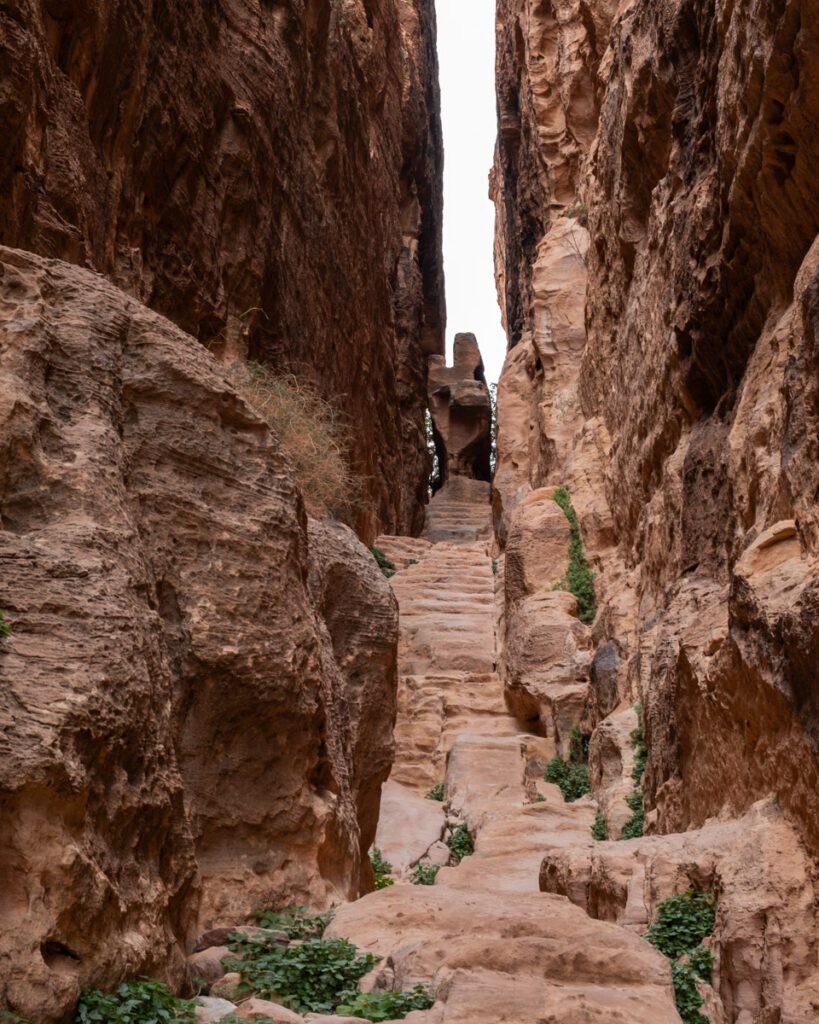
5. The Street of Facades, an impressive view in Petra
Right after seeing the Treasury, you’ll come head to head with the Street of Facades. This is the name given to the row of monumental tombs created by the Nabateans.
What makes this street so impressive is the fact that these tombs were carved into the cliffs. They’re elaborately decorated structures with intricate architectural details. The facades are crowned with corner crow-steps, pilasters and cavettos
Seeing so many of them makes this site quite incredible. Plus, if you can, we recommend hiking to the top facades to get an impressive view of the site, and to explore some of these tombs more closely.
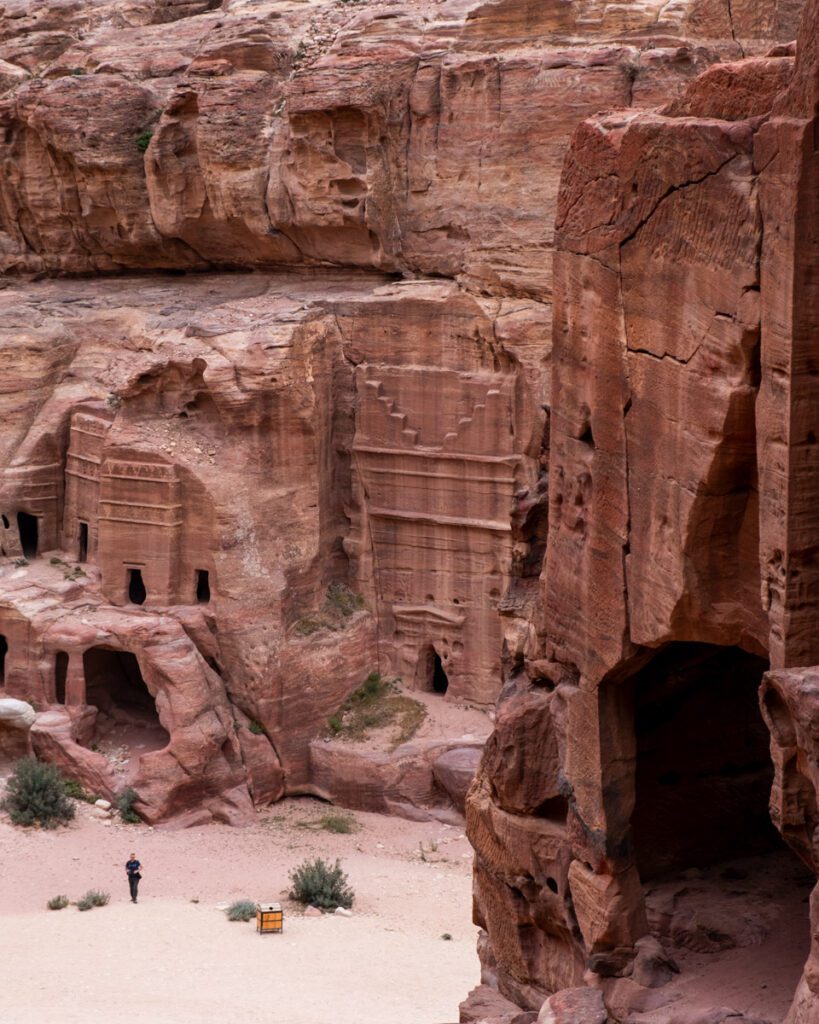
6. Discover the intricately designed Royal Tombs
If you were impressed by the Street of Facades, get ready to discover the beauty of the Royal Tombs.
Located next to the Street of Facades, above the rest of the site, you have a series of Royal Tombs. They are a group of four facades, one next to another. Each one is stunning.
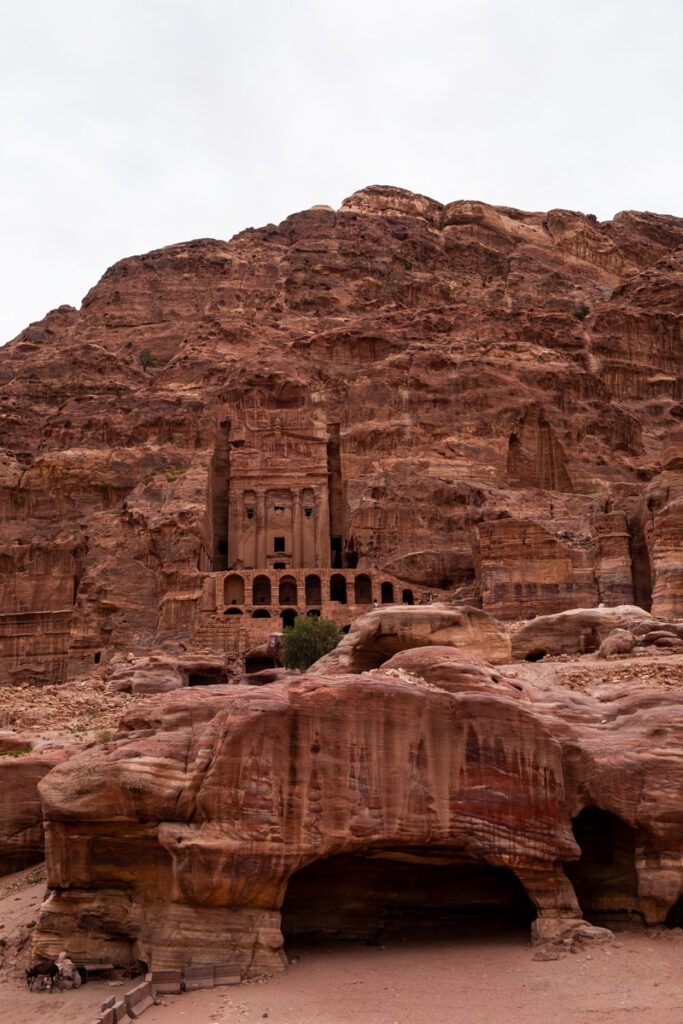
These were burial chambers and they’re also carved into the cliffs of Petra. The 4 main ones are the Urn Tomb, the Silk Tomb, the Corinthian Tomb and the Palace Tomb. Each served a different purpose at different points in time.
It’s well worth getting an up-close look at these tombs. They are truly beautiful.
You can reach them from the Street of Facades, or walk the path that leads to them from the main Petra street.
7. The Amphitheater, an impressive attraction in Petra
Located across the street from the Street of Facades, at the foot of the High Place of Sacrifice, you have the Amphitheater. Something we’ve come to expect in all the ancient cities in Jordan, like Amman, Jerash or Umm Qais.
The Petra Amphitheater was carved into the hillside of the cliffs and the back wall of the stage was rebuilt by Romans. This is the only theater in the world that is carved into the rock.
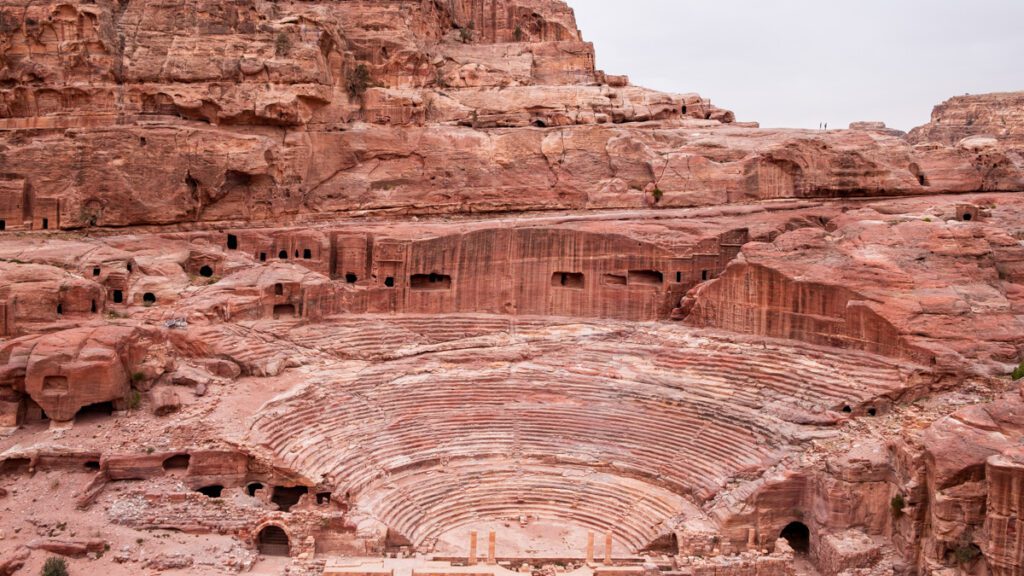
This Amphitheater was built in the 1st century CE. It’s made of 3 rows of seats separated by different passageways. There are 7 staircases that ascend the auditorium. It shows us a glimpse into what cultural and civic life was like in Nabatean times.
The number of people it could fit has been debated. Some sources say it could seat 4,000 spectators, while others say it can accommodate up to 8,000 spectators.
It’s believed that the theater was used for hosting various performances and events during its heyday.
8. The High Place of Sacrifice
We didn’t have a chance to see the High Place of Sacrifice. And unless you plan on walking 30,000 steps or have 3 days in Petra, chances are, you won’t see it either.
The High Place of Sacrifice is located at the top of a hill, overlooking Petra. It’s a hard hike up to this Petra attraction – about 3 km long, and taking between 3.5 to 4 hours.
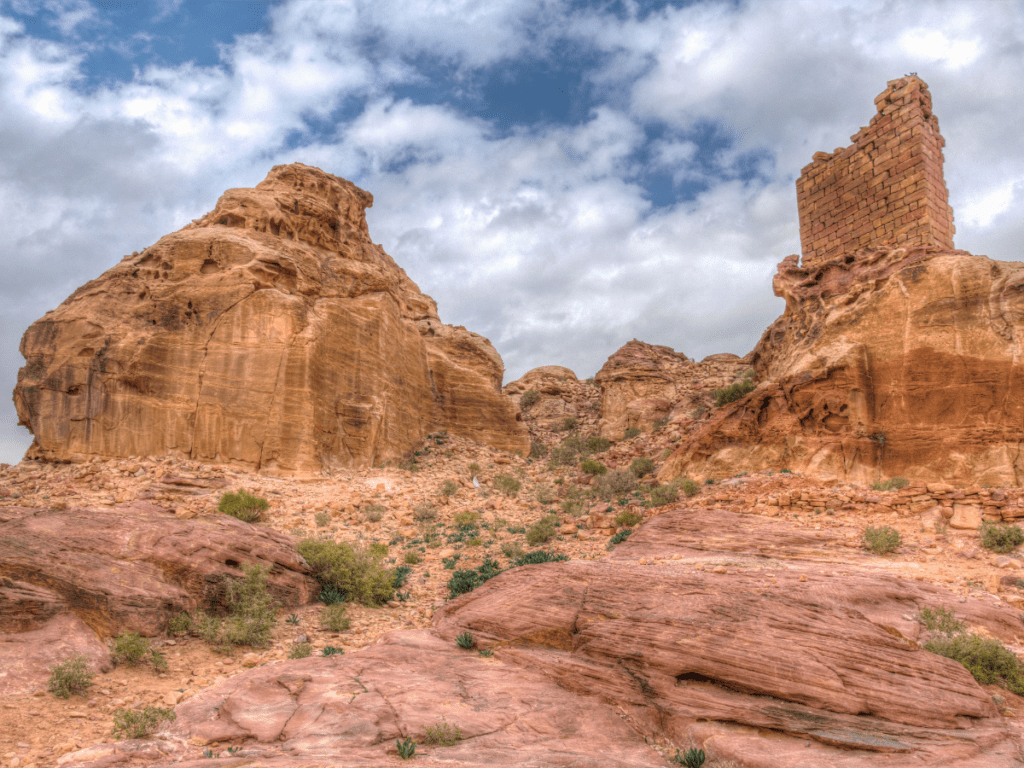
It’s a sacred ritual site, a place of worship dating back to ancient times. It was used by the ancient civilizations to celebrate important religious ceremonies.
Here, you can see altars, obelisks, and panoramic views of the surrounding landscape. Well worth it if you have the energy to make it up here.
9. The Djinn Blocks
Much easier to reach, you have the Djinn Blocks. They are located on the path between the main gate of Petra and the Siq. This is the first of Petra’s attractions you’ll see.
The three massive Djinn Blocks are squared monuments. Next to it, you’ll find the Obelisk Tomb and the Bab as-Siq Triclinium.
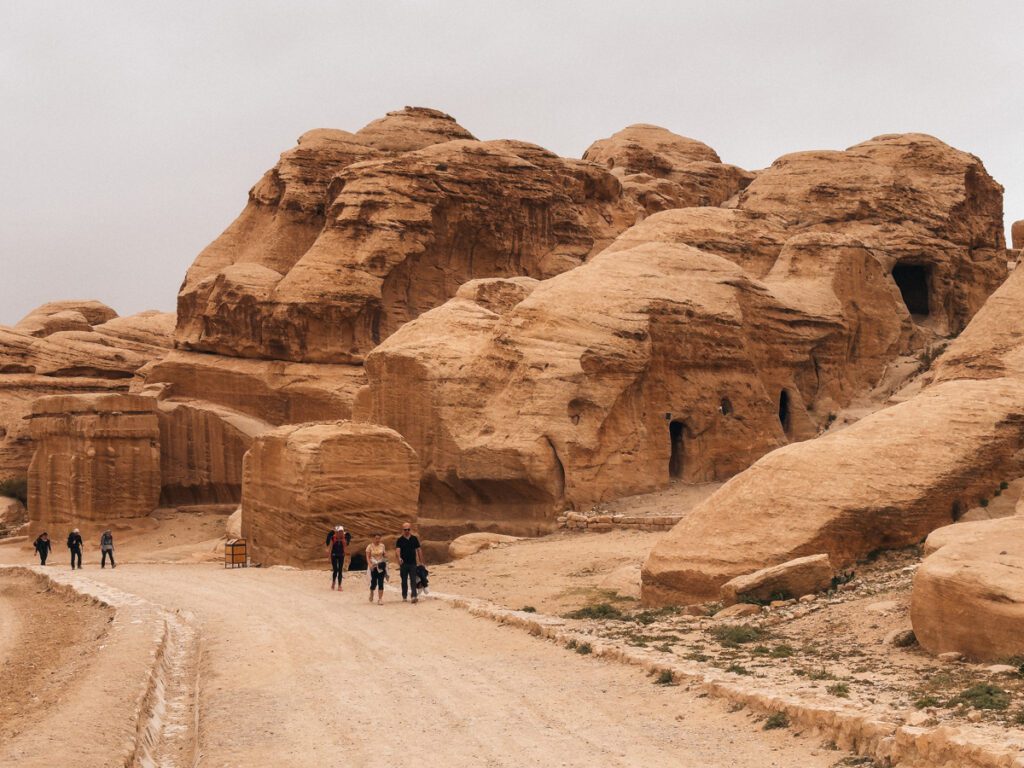
The Djinn Blocks are the three massive squared monuments. The name “Djinn Blocks” reflects the enigmatic nature of these structures, as the term “Djinn” refers to supernatural beings in Arabian folklore.
The Obelisk Tomb was carved by the Nabateans in the 1st century AD. Above it, you have 4 pyramids and a niche with a statue in bas-relief that symbolizes the 5 people buried there.
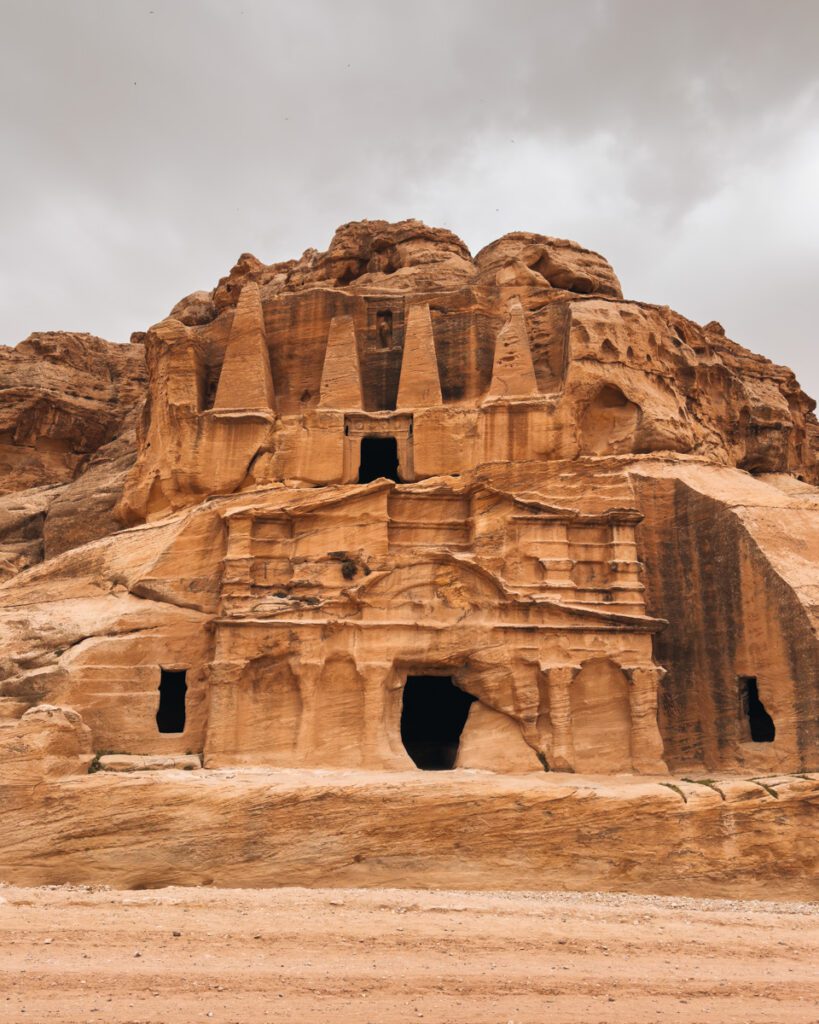
Below it, you have the Triclinium, a banqueting hall.
And opposite the cliff, there is a double inscription in Nabatean and Greek. It was written by Abdomanchos and it refers to the burial monument. It indicated that the tomb was to be used for himself and his family members.
It’s a first initiation to what you’ll be seeing inside Petra, before going through the Siq.
10. The Colonnaded Street
You can’t miss the Colonnaded Street. It’s located past the Royal Tombs, on the way to the Great Temple and the Monastery.
As its name indicates, it’s a street lined with columns. What makes it impressive is that it represents an original Nabatean creation. Although it was later refurbished during Roman occupation.
It is said to be one of the main shopping streets in the ancient city of Petra. Imagine what it might have been like when the city was inhabited. A bustling market with vendors.
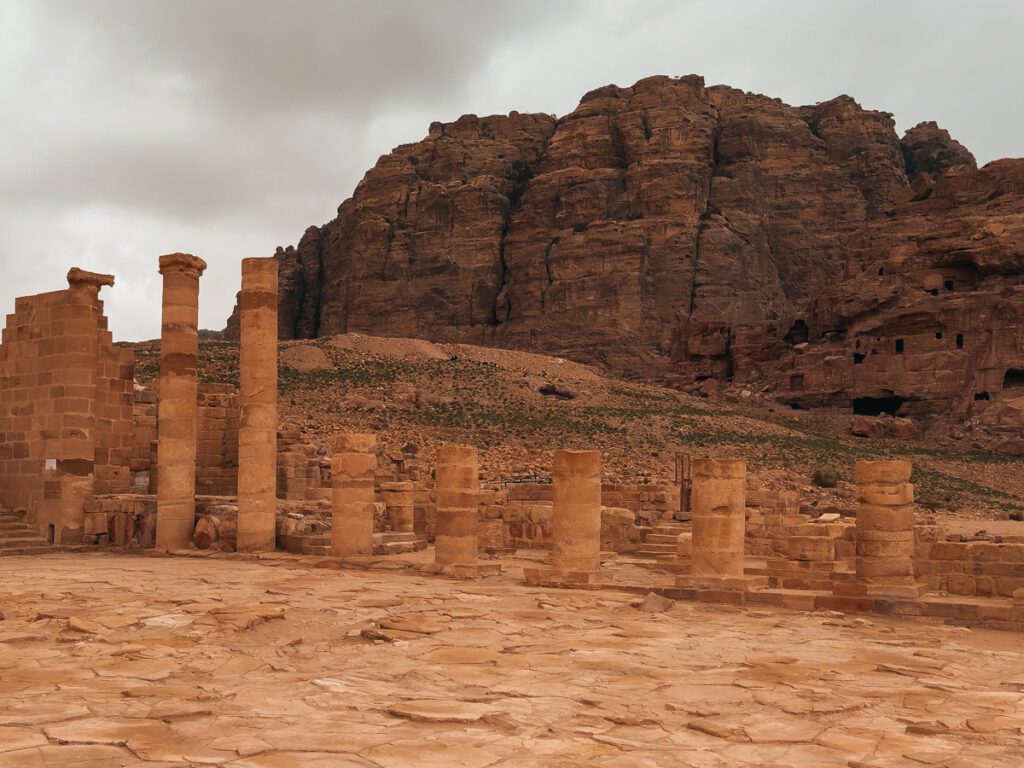
11. The Great Temple
Located right beside the Colonnaded Street, the Great Temple is another one of Petra’s highlights. And since it’s in the middle of the site, we can understand that it played a significant role during the Nabatean or Roman times.
The Great Temple of Petra is a testament to the religious and architectural prowess of the Nabateans. This complex, covering around 7,000 square meters, features a blend of Nabatean and Greco-Roman architectural styles, showcasing Petra’s role as a cultural crossroads.
It was built and expanded over several centuries. You can see its massive wall, colonnaded courtyards, and intricate carvings depicting gods, goddesses, and mythological scenes.
As one of the largest and most significant temples in Petra, the Great Temple likely served as a center of religious worship and civic ceremonies. It was dedicated to multiple deities, including Nabatean gods like Dushara and al-Uzza, as well as Greco-Roman ones like Zeus and Dionysus.
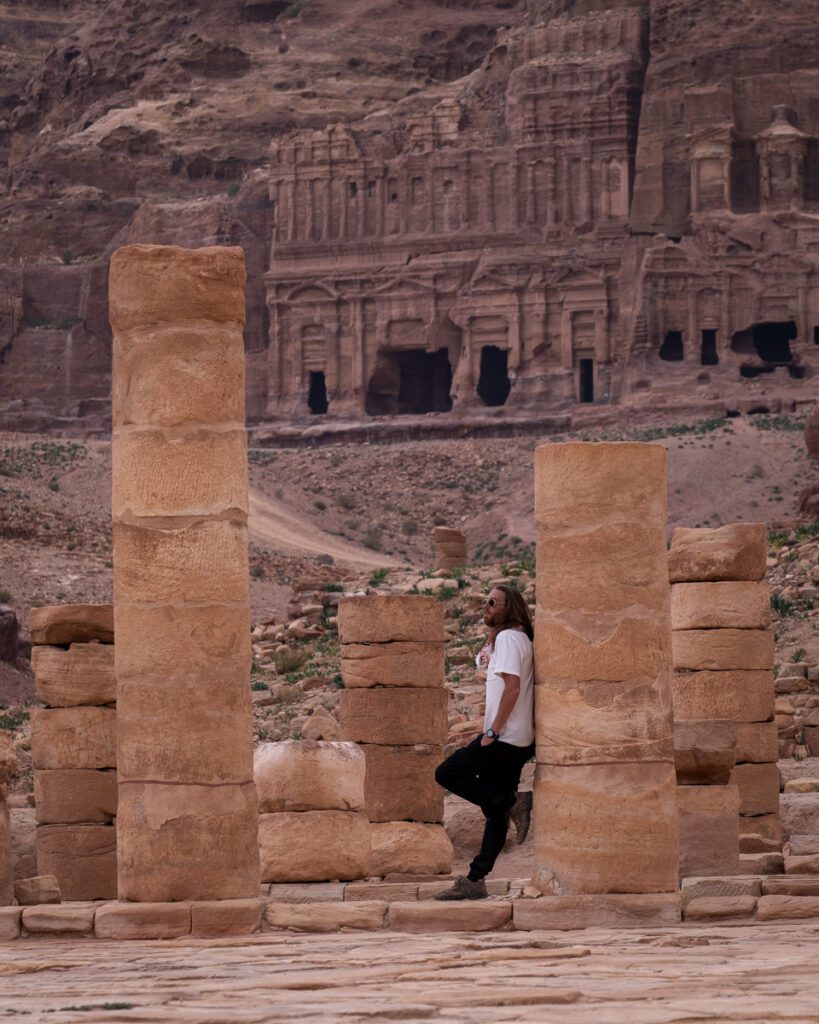
12. Qasr al-Bint
Another impressive structure is the Qasr al-Bint. A square structure that is set on a podium. It’s located between the Great Temple, the bathrooms and the restaurants that lead up to the Monastery.
Back in the Nabatean days, this Qasr was the main and most important temple in Petra. It was dedicated to Dushara – the main deity worshiped at that time. Dushara was considered the chief god of the Nabatean pantheon and was often associated with fertility, agriculture, and the protection of the city and its inhabitants.
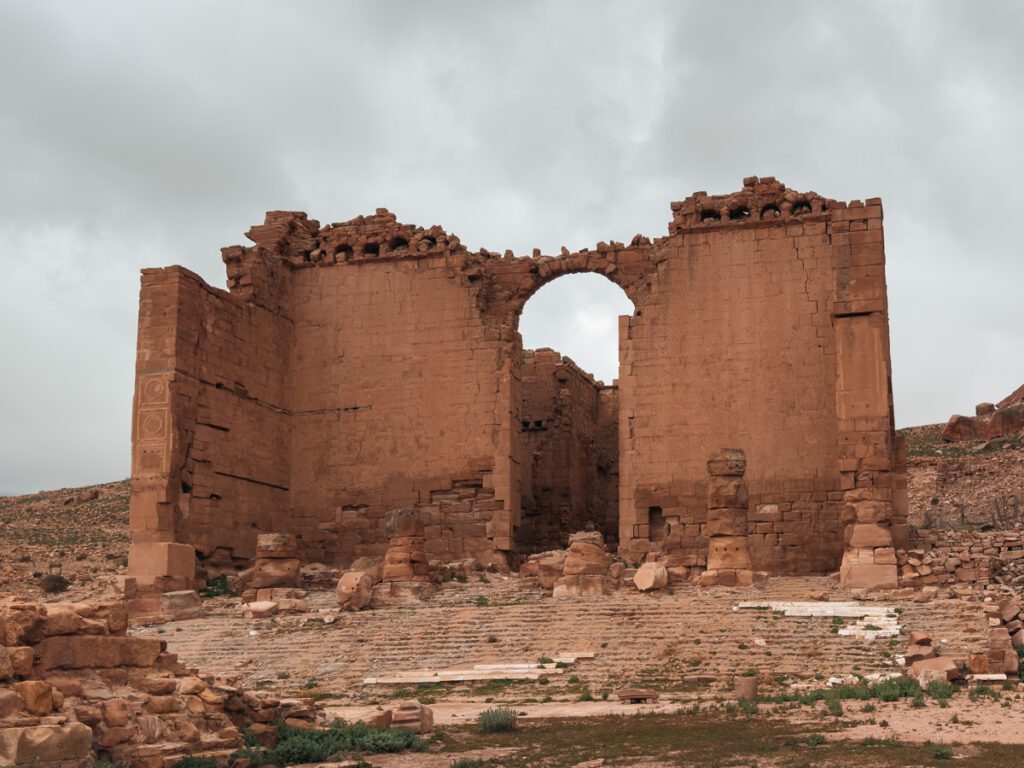
The Nabateans believed that Dushara played a crucial role in ensuring the prosperity and well-being of their community. They offered prayers and sacrifices to appease him. It was not rare to see elaborate rituals and sacrifices performed at this temple.
The temple dates back to the first half of the 1st century AD.
There are plenty of other sites to explore in Petra, but these are the main ones. You can read our full article about the attractions in Petra here.
How to explore Petra in 1, 2 or 3 days
You can spend a whole lifetime exploring the Ancient CIty of Petra and still not see it all. It’s huge and there are only so many steps you can take in a day.
This is why we wanted to help you out and let you know what you can expect to see in the Rose City, depending on if you spend 1 day, 2 days or 3 days in the site.
Of course, you can try to cram more in, but this will be hard to do unless you don’t mind being exhausted!
Just so you’re aware, the main trail, which starts at the Main Entry Gate and goes to the museum, just past the restaurants, before starting the trail to the Monastery, is a 3.5 km (2.2 miles) round trip. Not including all the deviations you’ll make to visit the many attractions in Petra. That’s a good 4+ hours of walking.
For the list of the best attractions, hidden gems and hiking trails in Petra, check out our article here.
Remember when buying your Jordan Pass, you will have 3 options: a 1 day pass to Petra, a 2-day pass or a 3-day pass. For the 2 or 3-day pass, you’ll have to visit on consecutive days.
When you get to Petra, they will check your Jordan Pass and print out specific tickets for Petra. You’ll need to have those tickets on you for every entry to Petra.
Petra in 1 day
If you have only 1 day in Petra, we would recommend you visit the highlights. This main trail is about 8 kilometers long and takes about 4 hours to walk if you’re not stopping at all.
Try to get there as early as possible and start from the main gate.
Take a look at the Djinn Blocks, walk deep into the Siq, taking the time to enjoy the sounds and sights of this deep gorge. Then, get to the Treasury and admire its beauty.
There is a small cafe in front of the Treasury. There are also a few benches there. You can have tea or coffee or enjoy snacks that you’re brought with you.
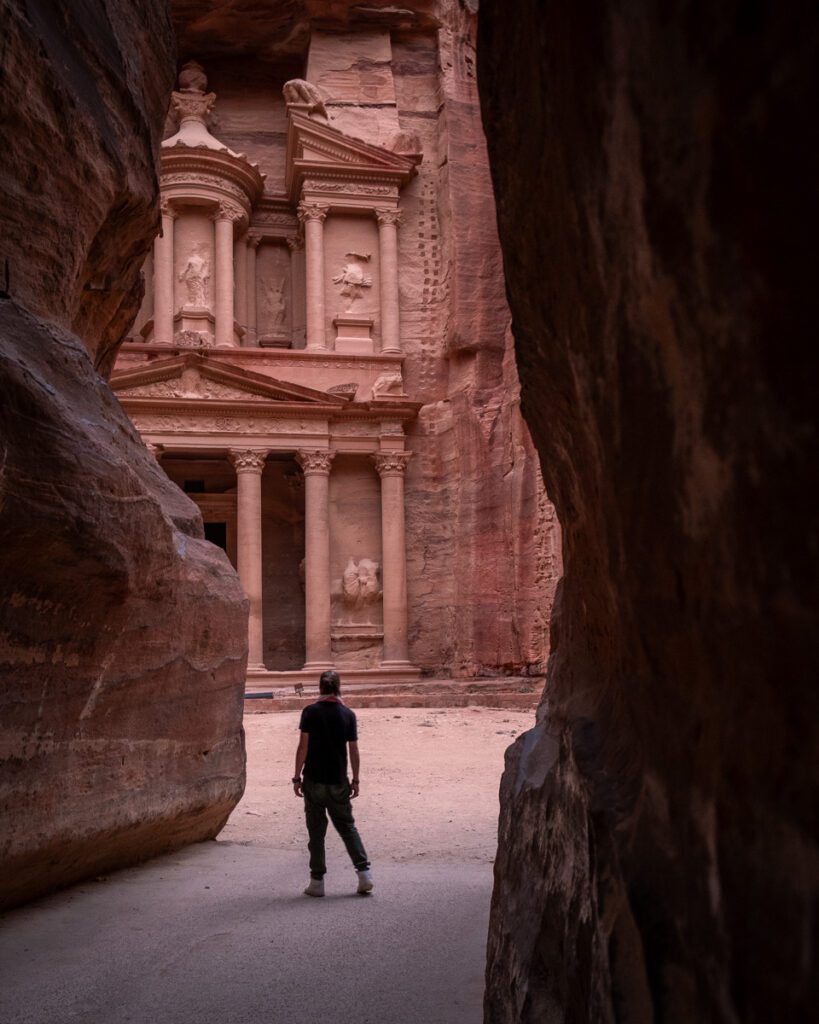
After this, head to Street of Facades, take a walk up to the top of the cliffs. Enjoy views of the amphitheater. Along the path above, walk to the Royal Tombs. Take the time to walk into them.
After this, head to the colonnaded street, the Great Temple and the Qasr al-Bint.
If you have the time and energy, you can try to make it to the Monastery. But this trail is another 2-3 hours long and it’s uphill (up many stairs) which you then have to walk back down. And then, you have to walk all the way back to the main entrance.
We don’t recommend going to the Monastery if you only have 1 day in Petra. Instead, we would recommend focusing on each of the highlights.
How to spend 2 days in Petra
If you have 2 days in Petra, we would recommend spending the first day checking out the highlights we listed above, but not going too deep into the site. Since you’ll be coming through the back door on your second day, you’ll be able to see the sites that are deeper in the site.
For your second day, we recommend taking the free shuttle to Little Petra. Take the time to visit this site and enjoy the different structures here. A good hour will suffice. There’s not a ton to see here, but it’s a nice getaway from the crowds.
Then, you have 2 options:
- If you are up for a 4-hour hike, we recommend taking the path to the left of the ticket office. There, you’ll start making your way to the Monastery.
- If not, you can take a Jeep ride (about 5 JOD pp) to the stairs that lead you to the Monastery. The Jeep ride will cut out about 1-1.5 hours from your hike. You’ll skip out on a mainly flat hike through the Bedouin camps.
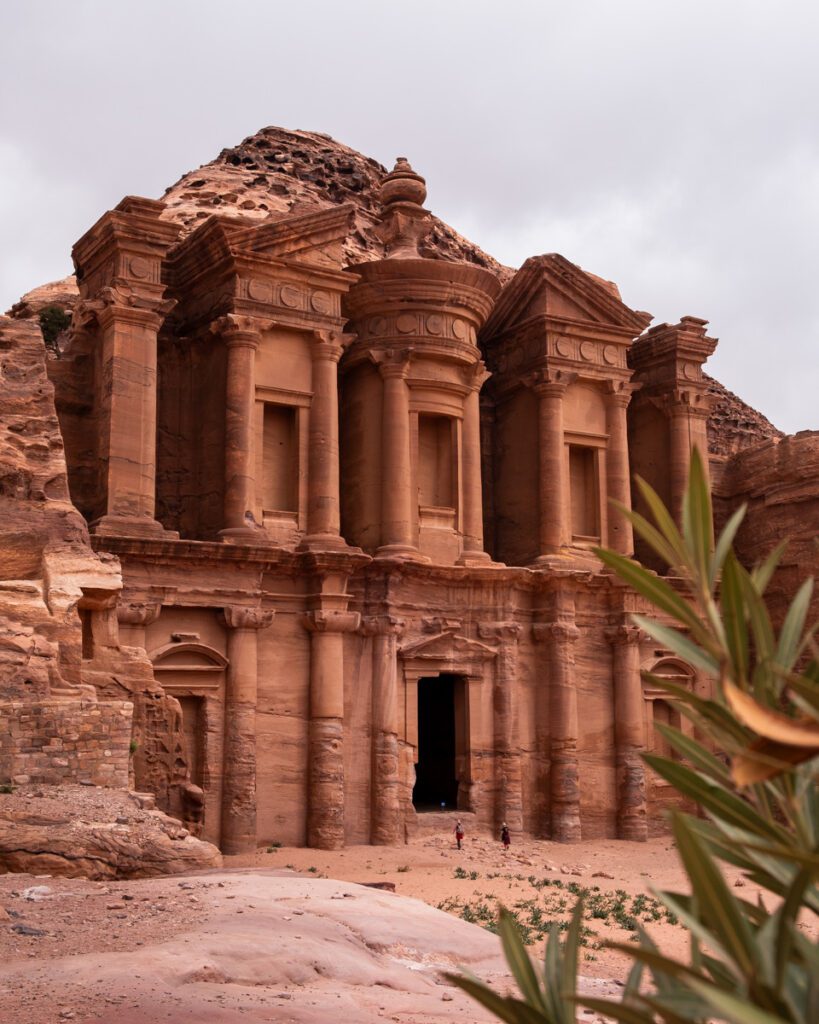
Hiking through the back way in Petra
The hike through the back way is beautiful. It’s not super difficult, though you do have to be in good health to do it. Make sure you pack lots of water and snacks. There are a few cafés along the path as well, in case you run out or want to support the locals.
You will need sturdy shoes (sneakers or hiking shoes will do) and some of the hike is uphill on rock-carved stairs. But it’s nothing too crazy according to us. To be honest, the hike up the stairs is worth the effort, considering the epic views you will get.
Along the hike, you’ll also have Bedouins offering to give you a donkey ride for a fee. Honestly, we don’t recommend it. It really doesn’t look enjoyable, and we worry about the welfare of these animals.
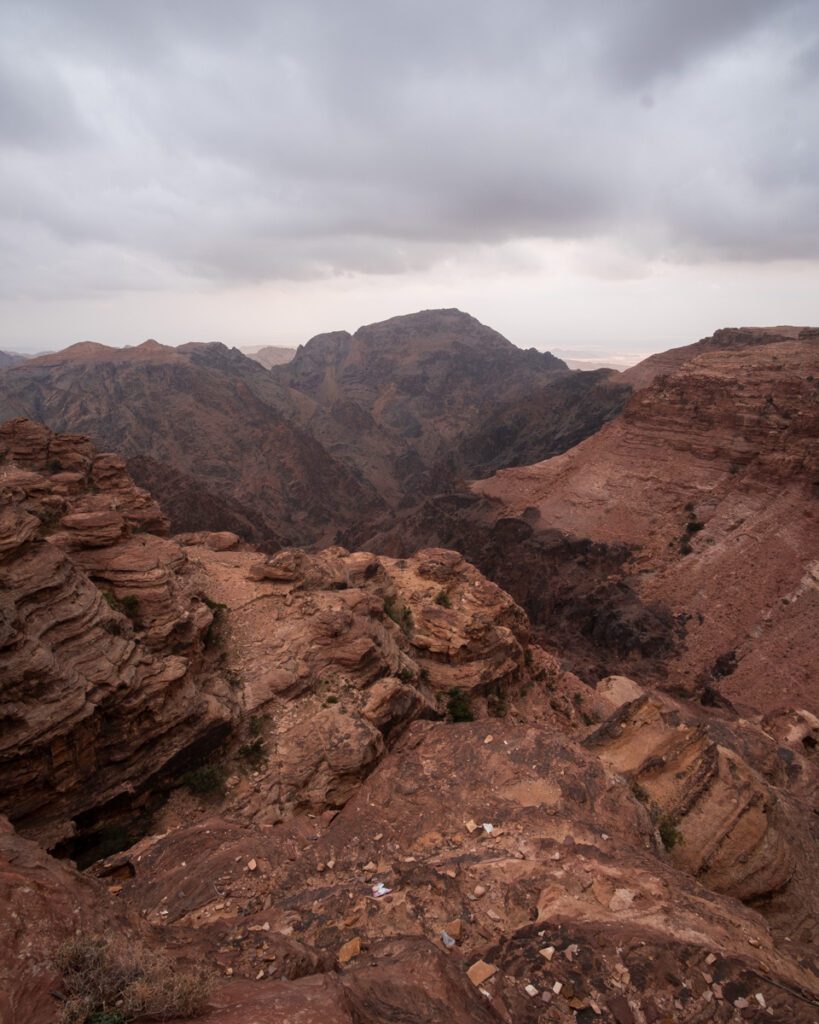
Instead, take your time and hike this trail. It’s beautiful and well worth the trek to the Monastery.
Once you get there, enjoy the views and when you’re done, start heading down the stairs to the main Petra site. You’ll be able to visit the highlights again but from a different vantage point.
On your way back, you can take the time to revisit some of your preferred sites from yesterday or concentrate on new ones.
You’ll exit Petra from the main entrance gate.
Petra in 3 days
If you have 3 days in Petra, you can take it a bit slower. For the full details, read the first 2 days’ itineraries and come back to this section.
On Day 1, visit some of the highlights, as many as you want or can by starting at the main entrance.
On Day 2, head to Little Petra and visit the site through the back way. Again, it’s up to you if you hike the full way, or take the Jeep to the stairs.
On Day 3 in Petra, visit the sites that are further to get to.
- The High Place of Sacrifice looks amazing, but it’s a hard site to get to. It’s a hard 3-km round-trip hike up a few hundred stairs. If you plan on doing it, start out early as the heat and sun get stronger in the afternoon and later in the day.
- There is a hike starting from behind the Royal Tombs, that heads all the way to an amazing viewpoint in front of the Treasury. This is where you see most of the Instagram pictures of people sitting with an elevated viewpoint of the Treasury down below. This is the Al-Khubtha trail. It’s about 3.5 km round-trip and takes between 2.5-3 hours. If you’re up for it, you’ll be rewarded with some amazing views. You might want to pick between this hike or the High Place of Sacrifice.
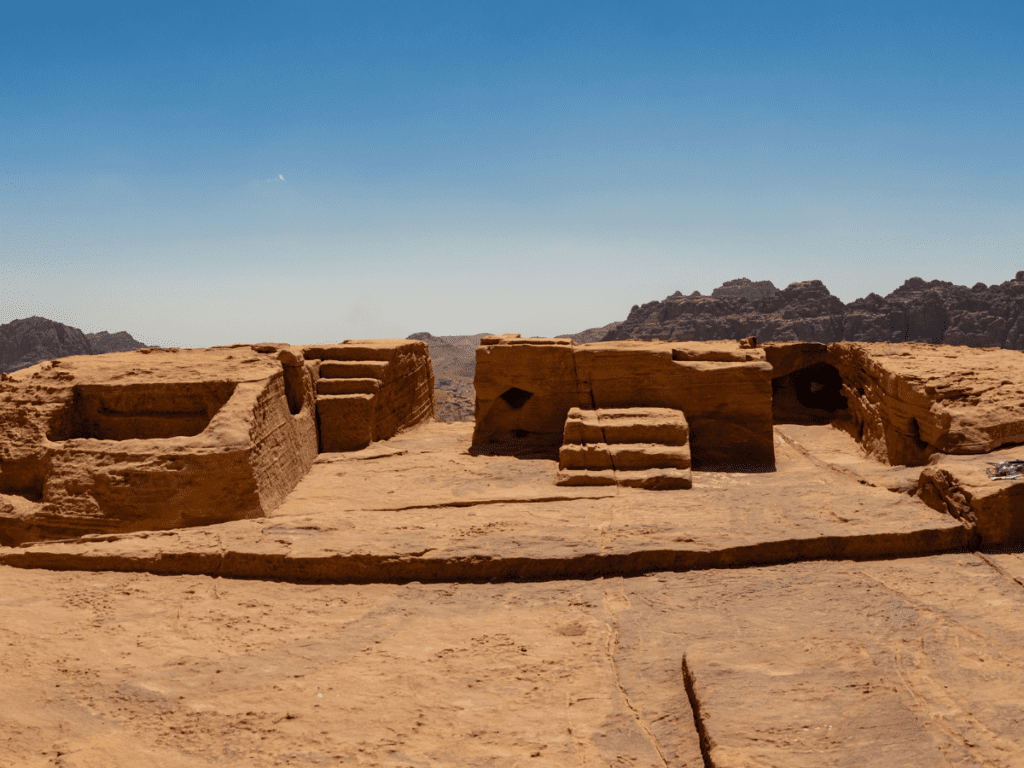
- The church has a beautiful mosaic floor. It’s a bit off the path. It’s not a long walk to get to, but chances are, if you hiked all day from Little Petra, your legs will appreciate the break.
- The Great Temple is actually quite large. If you didn’t have a chance to see it fully check it out today.
- The Petra Museum is a great place to learn more about the history of the ancient city and to see some well-preserved artifacts that were found on the site.
This will give you enough time to see the best sites in Petra, and then some.
Petra at night
If you want to have a special experience at Petra, there’s always the option to buy tickets to Petra by night. This is a night show that happens every Monday, Wednesday and Thursday. You’ll need to buy tickets in advance and plan your Jordan itinerary accordingly.
During Petra by night, the space is lit up by over 1,500 candles along the entire length of the Siq, up to the Treasury.
The event starts at 8:30 pm and ends at the Visitor Center at 10:30 pm. The entrance fee for Petra by Night is not included in your Jordan Pass. It’s an additional 17 JOD per person, but free for children under 10.
You can get your tickets at the Main gate of Petra, or from your Hotel reception.
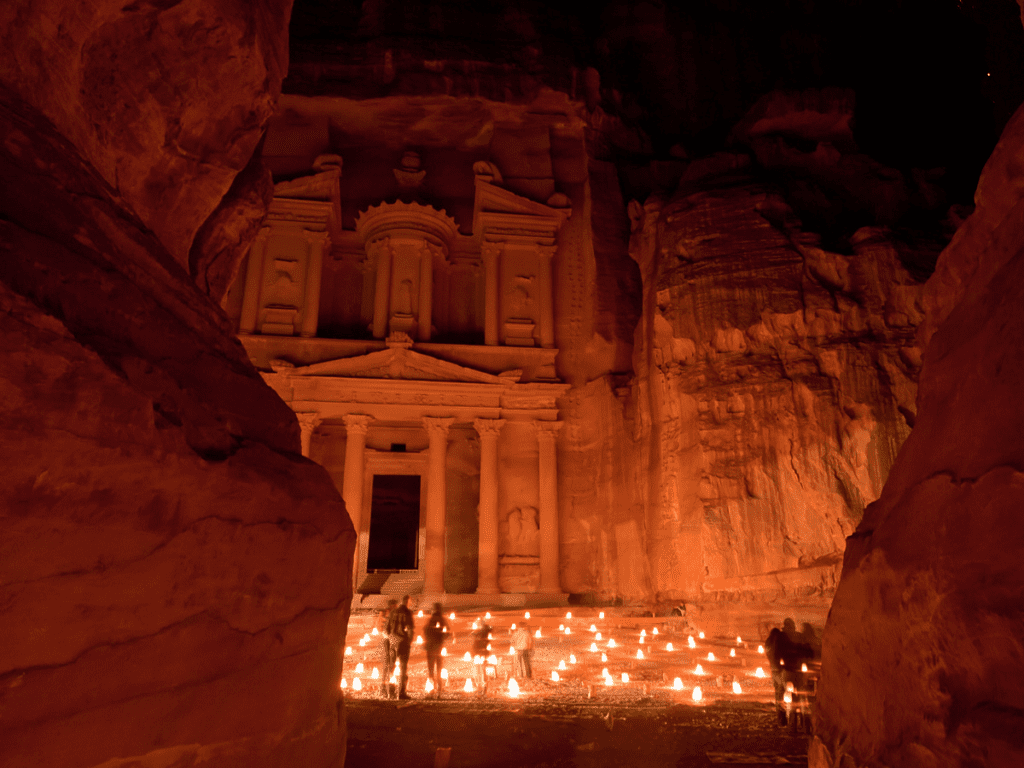
Everything to know about visiting the Ancient City of Petra
When it comes to visiting Petra, there are a few things to know when planning your trip. When is the best time to visit Petra? What are the entrance fees? Is it included in the Jordan Pass? Should you get a guide?
We’re here to answer all these questions and more!
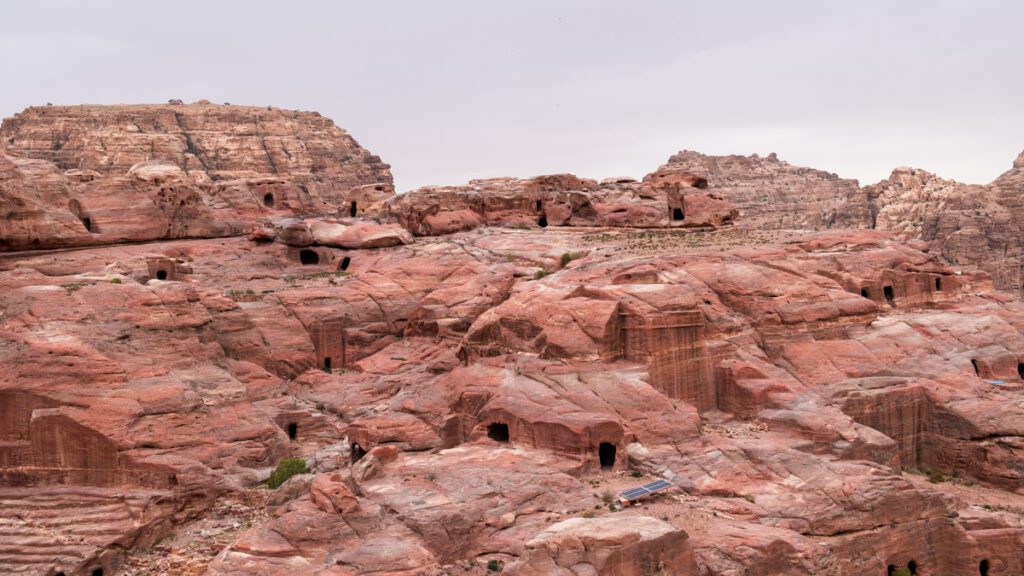
What are the opening hours for Petra?
The Ancient City of Petra and the Visitor Center are open daily from 6:30 am until 5:30 pm. Even during Ramadan, when we visited, these hours were unchanged. We stayed well past 6 pm and the guards didn’t say anything.
As for Little Petra, it’s free to visit, but if you want to enter the site, the ticket office there opens every day from 7 am until 2:30 pm. The hike to the Monastery will take a good 3-4 hours, which means if you get the last entry, you’ll be leaving Petra quite late. We would recommend getting an early start if that’s your plan.
When is the best time to visit Petra?
The best time to visit Petra will greatly depend on what you’re looking for in terms of weather, crowds and overall experience. But usually, it’s recommended to visit in the spring (March to May) or the fall (September to November) – this is when the weather is milder.
Petra in the spring
From March to May, you can expect temperatures ranging from 15°C to 25°C (59°F to 77°F). We visited in March and the weather was between 18-20°C – nice enough to be in a t-shirt but with some layers in case.
Note that rainfall is possible in the spring. During the 3 nights we spent in Wadi Musa, we saw torrential rain every day. Although it didn’t last long, and it was mainly in the late afternoon or the evening, it was not negligible. Pack accordingly.
Although March was too early to see the wildflowers bloom, we did see more green on the hills of Petra. In Wadi Rum, however, we did see these flowers which added nice punches of color to the scenery.
If you want to escape the crowds in Petra, March is a great time to visit. As spring progresses, the crowds tend to get bigger.
Visiting Petra in the fall
The autumn months in Petra are quite similar to the spring. From September to November, the temperatures are milder and the weather is more comfortable to explore the highlights of Petra.
Compared to the peak summer months, the crowds are smaller, so you can enjoy your surroundings a bit more.
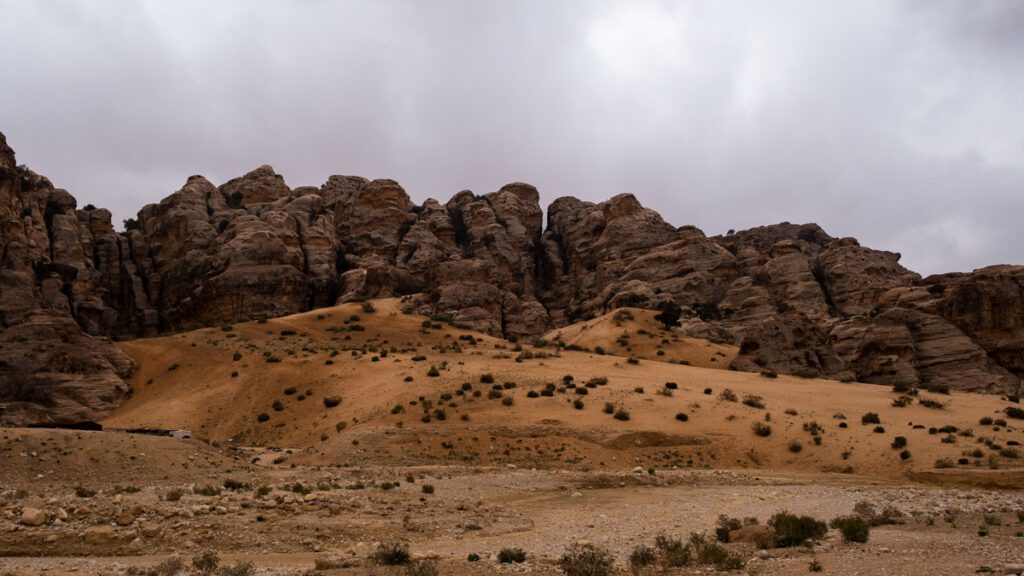
Summer in Petra
From June to August, the weather in Petra is extremely hot. Temperatures often exceed 30°C (86°F) and sometimes, they can reach over 40°C (104°F) during the peak hours of the day. Not great for visiting Petra where there is minimal shade.
If you don’t mind the heat and the crowds, this could be a good time for you to visit. However, know that Petra, and Jordan as a whole, are much busier during these months.
If you want to have a break from the heat and the crowds, you can visit in the early morning or late afternoon.
The winter in Petra
Finally, from December to February, it’s winter in Jordan. Temperatures are much cooler, but the upside is that there are barely any crowds.
During the winter months, daytime highs average around 10°C to 15°C (50°F to 59°F). It’s a bit cooler in the early mornings and later in the afternoon, especially at night. Make sure you pack accordingly.
What makes the crowds flee visiting Jordan in the winter is the possibility of rainfall. However, rain is rare in the desert climate of Petra. However, when we visited in March, our nights were always rainy.
Make sure you pack accordingly!
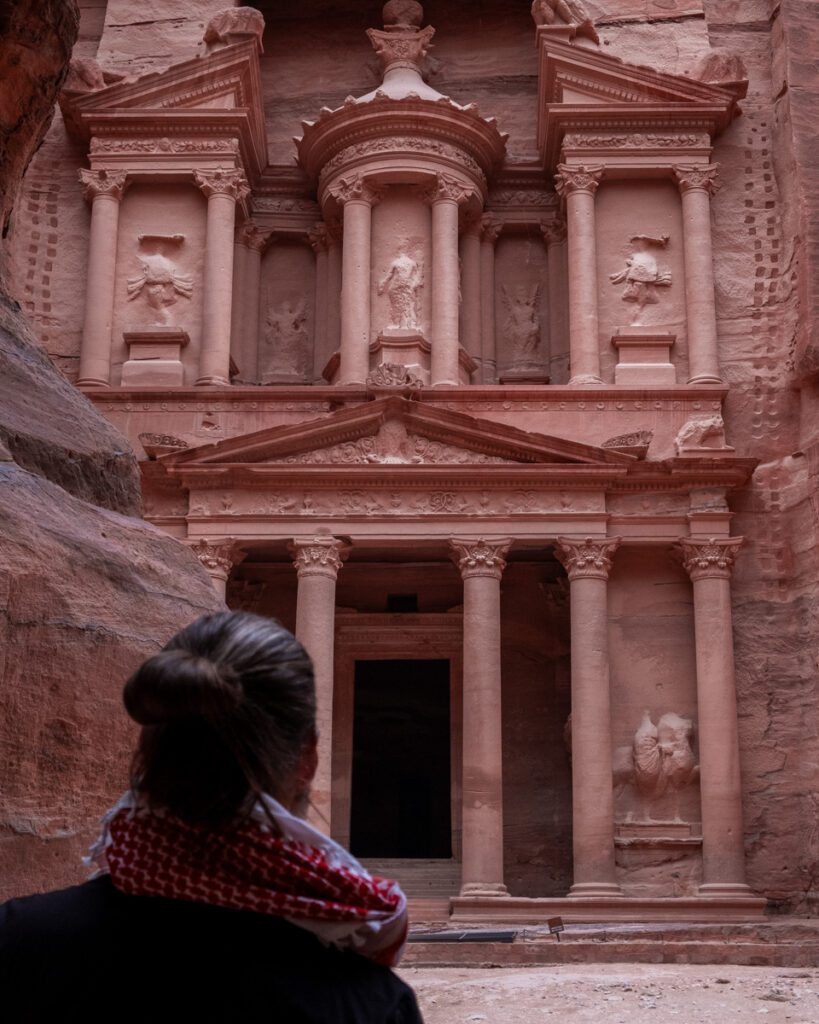
What are the entrance fees for Petra?
The entrance fees for Petra are included in the Jordan Pass. In fact, the price of your pass will vary depending on how many days you choose to spend in Petra.
The Jordan Wanderer pass gives you 1 day to visit Petra, along with all the other attractions included in the pass. This costs 70 JOD. This is the best option if you have limited time in Jordan and only want to see the highlights of Petra.
The Jordan Explorer allows for 2 consecutive visit days to Petra (and all other attractions). The cost of this pass is 75 JOD. If you want to go beyond the highlights and hike the back way, this is the option we recommend.
The final pass is the Jordan Expert, which gives you 3 consecutive visit days to Petra and costs 80 JDs. This is the right option for you if you want to see as much as possible within the Ancient City of Petra.
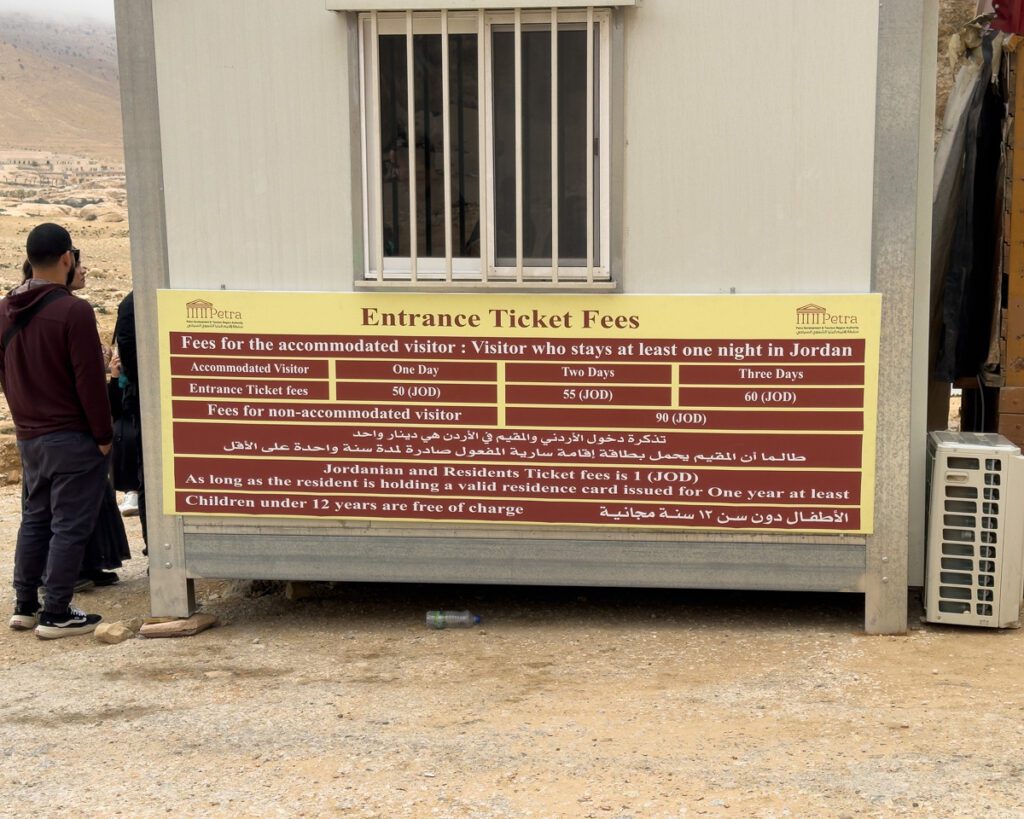
If you don’t want to get the Jordan Pass, here are the entrance fees for Petra:
- If you have at least 1-night accommodation in Jordan:
- 1 day entrance fees for Petra: 50 JOD
- 2 days entrance fees: 55 JOD
- 3 days entrance fees: 60 JOD
- If you don’t have at least a 1-night accommodation in Jordan, the fees to enter Petra are 90 JOD
- For Jordanians and residents, the fees are of 1 JOD
- Petra is free to enter for children under 12 years old
Should you get a guided tour in Petra?
We seriously considered getting a guide to visit Petra – it’s the best way to fully understand what you’re seeing and to dig deeper into the history of this storied place.
However, what stopped us was the price. 50 JOD for a 4-km tour that would take you until the Colonnaded Street (maybe a bit further down the main path). A bit too steep for us!
If you want to take a guide through the main way as well as to the High Place of Sacrifice (6km) or the Monastery (8km), the price is 100 JOD, regardless of the size of the group.
If budget is of no concern to you and you really want to learn more about the site, then it would be a good idea to get a guide. There are many accredited guides available at the Petra Visitor Center and they speak many languages.
If you make friends while in Petra, you can group together and split the cost of the guide. This will be a much more budget-friendly!
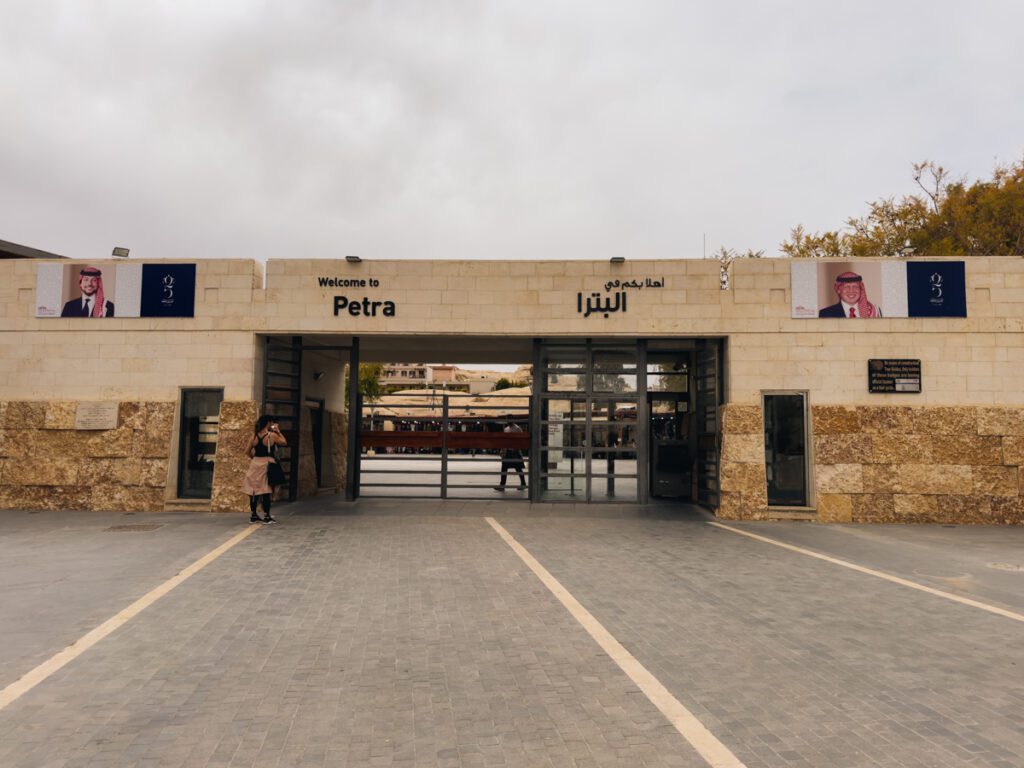
What to wear to visit Petra
When visiting Petra, you need to keep in mind that your days will be long, and you’ll have a lot of walking to do. While we were there over 2 days, we walked about 25,000 to 30,000 steps per day.
The main thing you should wear is comfortable shoes. We mentioned it, you’ll be walking a lot! We recommend wearing close-toed shoes. Sneakers, hiking shoes or running shoes. Wear breathable and soft socks as your feet will need the break.
Wear comfortable and breathable clothing. We recommend light pants and long-sleeved shirts to protect you from the sun. Also, don’t forget to wear sunscreen and to reapply as the day progresses.
There’s not a lot of shade or coverage in Petra. So covering up with clothing – pants, shirts, a hat, will be very practical.
You’ll also want to bring a warmer layer, especially if you plan on hiking a lot, and depending on the time of year you visit.
While we were there in March, the weather was unpredictable. It was sunny at some points of the day, then cloudy and a bit chilly. We also got crazy winds, especially when you’re out of the gorge or out in the open. There was also a drizzle, though we were expecting more rain.
We also recommend bringing a backpack to store your food, water and layers in.
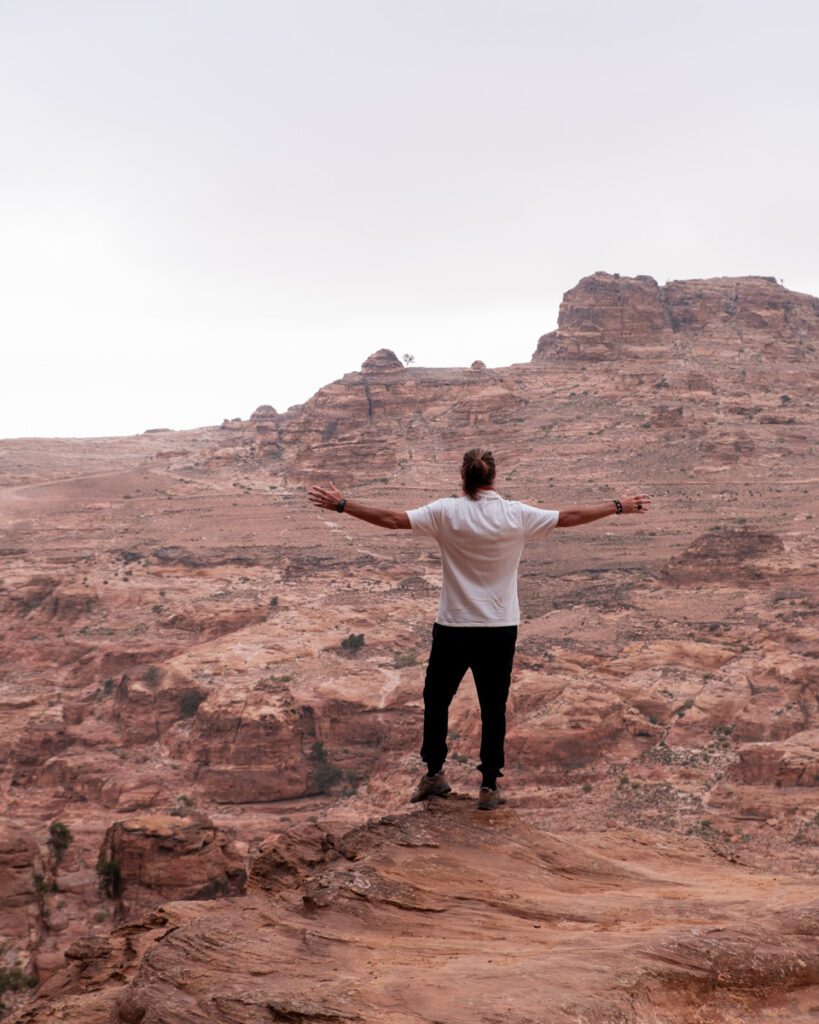
Food options in Petra. Should you get a box lunch or eat in Petra?
We’ve gone through what to wear, now let’s talk about what to pack for your trip into the ancient City of Petra.
First is water.
There are stalls and restaurants in Petra, but nowhere you can fill your water bottle. that’s why we recommend coming with ample amounts, especially if you want to hike from Little Petra.
Next, when it comes to food, you have three options.
Packing your own lunch to visit Petra
You can pack a lunch with things you buy from grocery stores in town. You can get some snacks, veggies, hummus in a box, bread and make your own sandwiches.
This is what we did, and we loved it because we stopped and enjoyed our treats with the view of our choice. Plus, we were able to control the cost of our lunch and pack only what we wanted.
Purchasing a box lunch to visit Petra
Many hotels and restaurants will offer to pack you a lunch. They have set menus that include a drink, a sandwich, fruits and veggies, and more. Prices will vary from 3 JOD to 10 JOD, depending on what they pack for you.
Some places offer 2 sandwiches in each lunch box, which is great if you want to share your meal with someone. Other places have set menus but are willing to make concessions based on your dietary restrictions or preferences.
However, not all are so accommodating. Our hotel didn’t want to change the nature of the sandwiches but didn’t offer vegan options for Carine. We did find another restaurant, a block away from Petra, that was glad to change the contents of their sandwiches at no extra price.
If you’re looking for a hassle-free lunch and you don’t have dietary restrictions, this is a great option to bring food into Petra. The main downside is that it can get expensive, depending on where you get your meal.
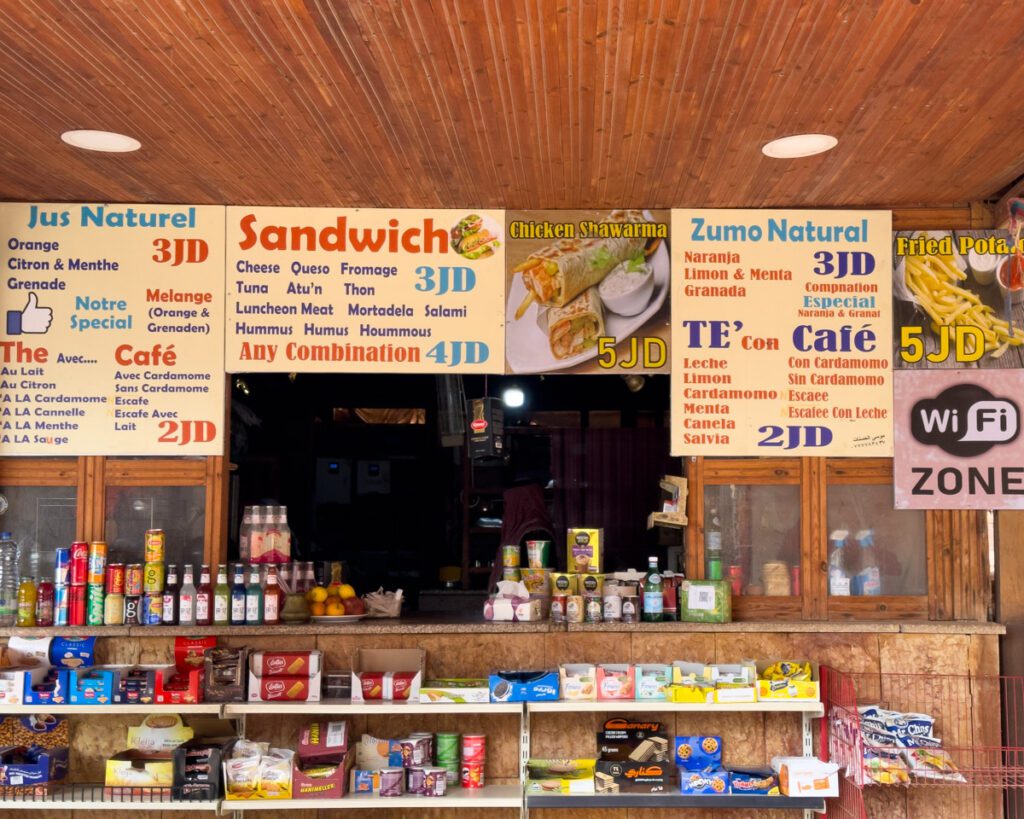
Restaurants in Petra
Finally, there are restaurants and stalls in Petra where you can stop and get a meal, snacks or drinks (water, tea, coffee, etc.).
Looking at the prices, they weren’t as crazy as all the vendors outside Petra make you think. Our hotel warned us that a bottle of water would be 8 JOD… That was not the case.
In fact, the prices in Petra were similar to what we saw in certain restaurants, plus a little premium. To be expected when you’re eating in front of the Treasury or the Monastery!
If you don’t want to bring lunch into Petra and you don’t mind paying a premium, this is a good option for you.
Are there toilets in Petra?
Yes, you don’t need to worry about that. There are many toilets available in Petra and they are free to use. There are bathroom attendants there, so feel free to tip them.
The toilets in Petra are located at various strategic points and they’re not too far from each other. You’ll find them at the following points:
- Visitor Center
- The Dam (right before entering the Siq)
- Street of Facades
- By the Royal Tombs
- Across the Qasr Al-Bint
Note that we didn’t see any bathrooms at the Monastery or at Little Petra.
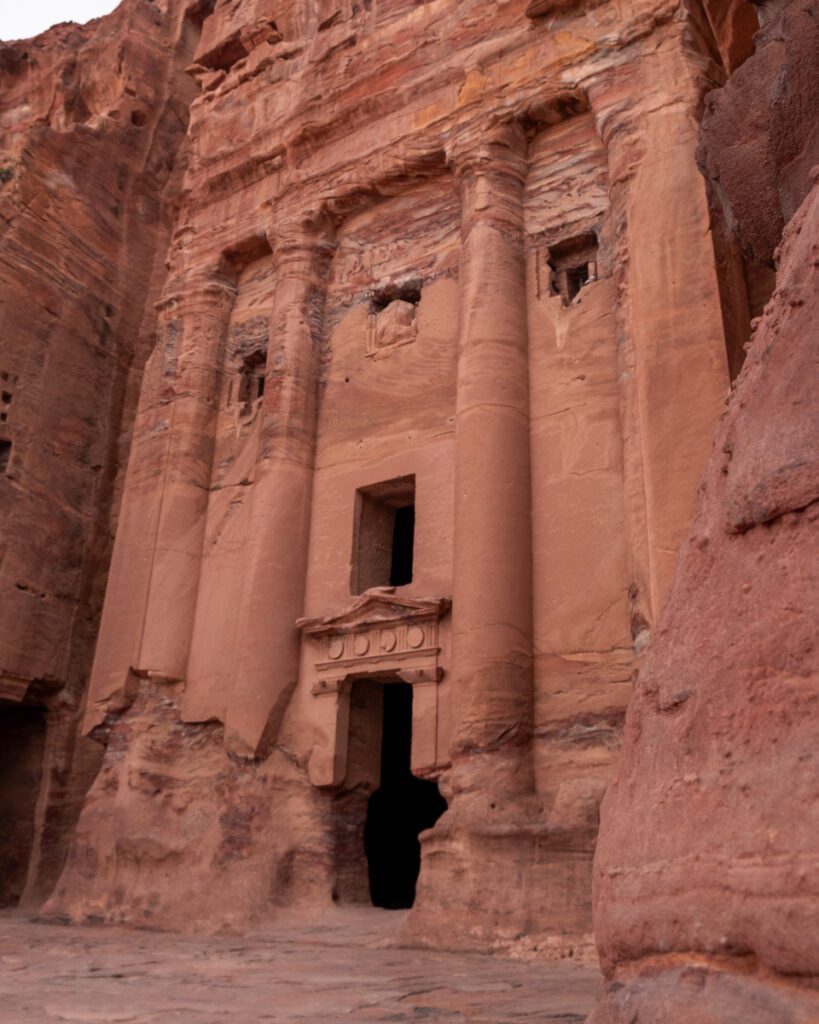
Should you take a day trip to Petra?
The real answer is no. A day trip to Petra is not ideal. But, if you only have a limited time in Jordan, like a day or two, then sure, swing by Petra for a little teaser… But make sure you come back when you have the time.
To us, you need more than half a day to fully immerse yourself in Petra’s immensity and magical vibes. There’s a reason this place is not only a UNESCO Heritage site, but also, one of the 7 Modern Wonders of the World.
The drive from Amman to Petra is 3 hours long. Round trip, you’re spending 6 hours of your day driving. This leaves very little time on the actual site. Even if you get there early and leave late, you’ll barely scratch the surface. You might get to see some of Petra’s highlights, and that’s about it.
We suggest having at least 1 full day in Petra. If you have the time in your Jordan itinerary, we actually recommend you do 2 days there. It’s the best way to truly get a feel for the place, see more than just the highlights and understand how significant this place really is.
Things you didn’t know about Petra
Although we covered as much as possible about Petra, here are some facts you might not know about!
Petra has an impressive water management system
Even if it’s located in a desert, Petra has a sophisticated water management system. It allowed the city to thrive.
The Nabateans constructed dams, cisterns, and water channels to capture and store rainwater, ensuring a sustainable water supply for the city’s inhabitants.
In fact, you can still see some of those water channels, especially in the Siq where there are “pipes” along the walls where water used to flow back in the day.
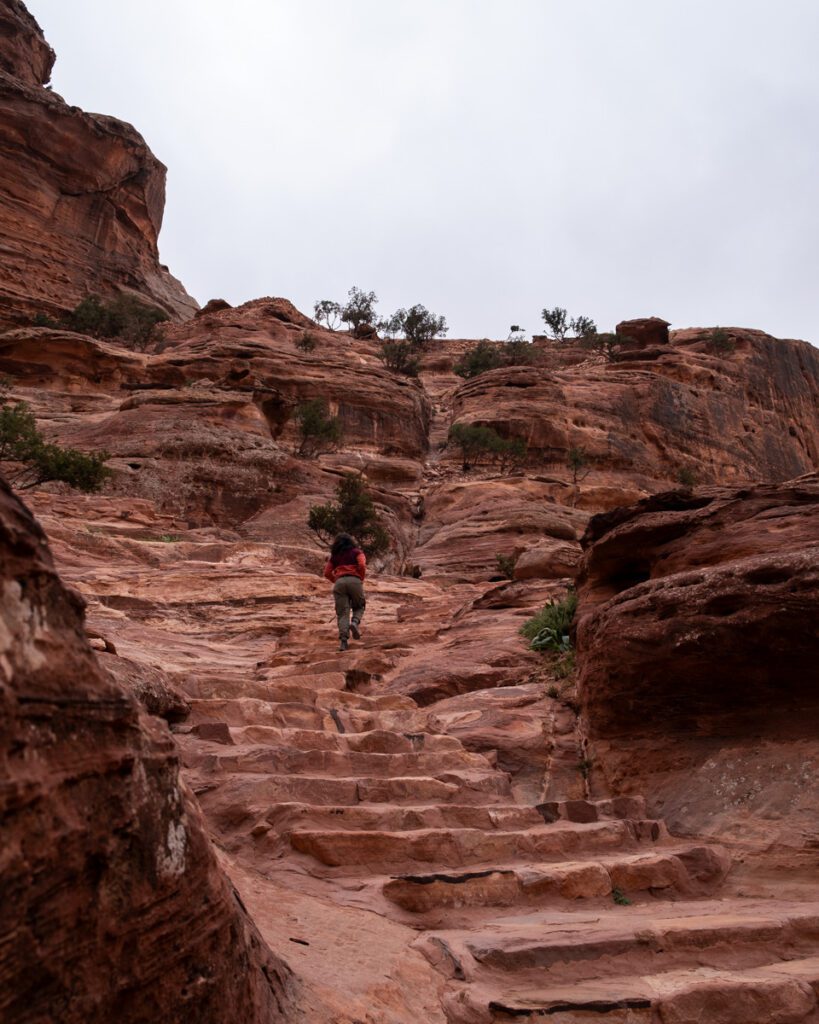
Graffiti in Petra
All throughout the ancient city of Petra, you can find ancient graffiti and portraits carved into the rock walls. This gives us a glimpse into the lives of past inhabitants.
These inscriptions include names, dates, and symbols left behind by travelers, traders, and pilgrims who passed through the city over the centuries.
Petra’s role in the spice trade
Petra is renowned for its role in the incense trade. But what many didn’t know is that it was also an important hub for the spice trade.
Merchants from across the ancient world would come to Petra to exchange spices like cinnamon, pepper and cloves, highly prized commodities back in those days!
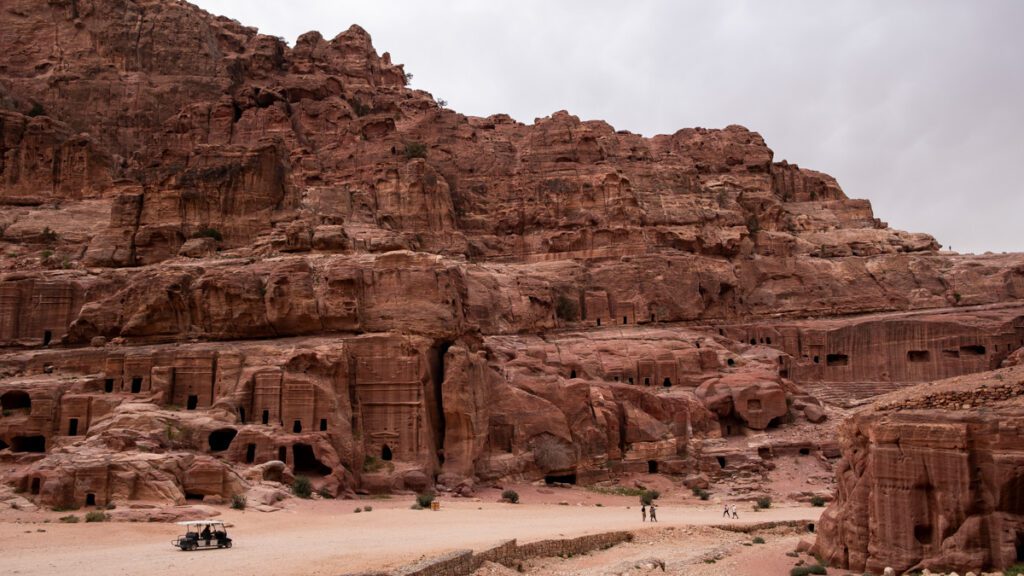
Petra’s tombs were also homes
Many of Petra’s tombs were burial chambers, but some were later repurposed as homes by inhabitants.
These ancient dwellings feature doorways, niches and other modifications that provide insight into how Petra’s urban landscape evolved over the centuries.
Petra was home to religious diversity
While Petra is often associated with the Nabateans and their pagan religious practices, the city was also home to many different religious beliefs.
Over the centuries, Petra’s inhabitants practiced various faiths, including Christianity and Judaism, leaving behind evidence of their religious activities in the form of churches, altars, and sacred sites. You can visit many of them today when you go through the highlights of Petra.
Scattered throughout Petra are rock-cut sacrificial altars. This is where animals were ritually slaughtered as offerings to the gods. These altars typically feature depressions for collecting blood and channels for draining it away.
Animal welfare at Petra
It’s not all that surprising to think that the animals at Petra are not that well taken care of. In fact, things used to be really bad here, until Sara and her team showed up!
We met Sara at one of the best restaurants in Amman: Bayt Sara. Sara owns this vegan restaurant and helps take care of animals in Amman and at Petra. In Amman, she and her family take care of over 160 cats and some dogs. But some of the best work Sara does is in Petra.
Seeing how poorly the donkeys, horses and camels were treated in Petra, she started a petition and a movement to remove the animals from the site. It’s thanks to her efforts that these animals are now taken care of and have better lives.
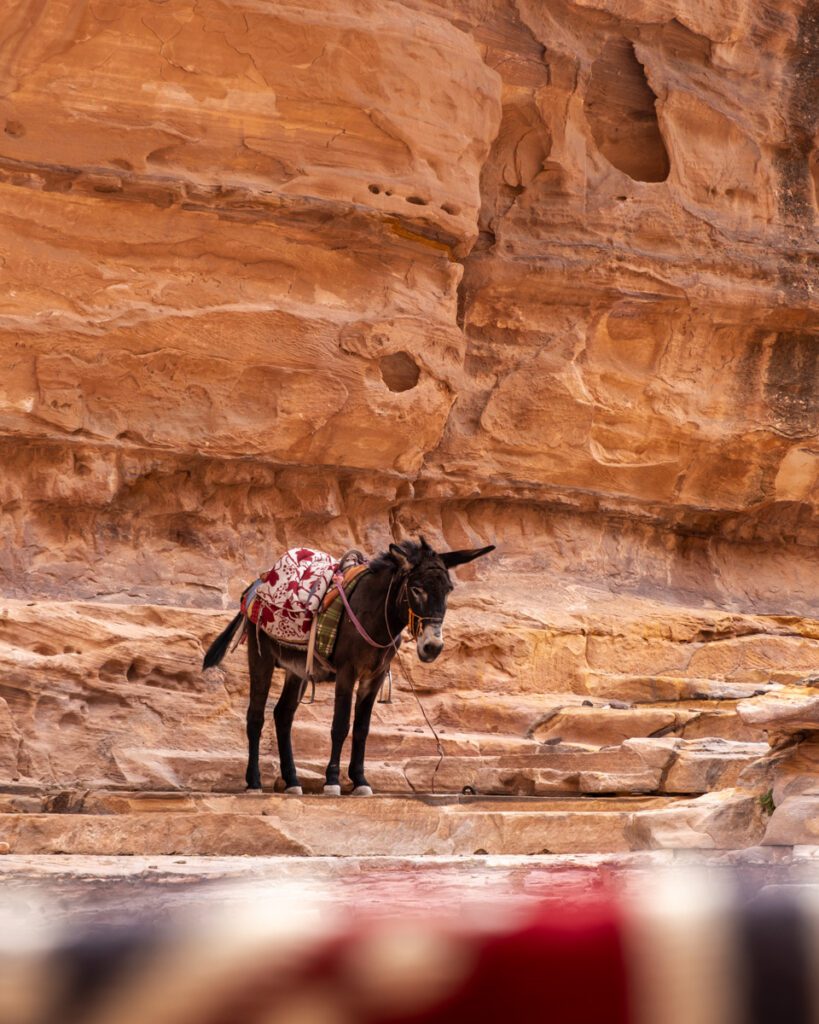
Sara started a veterinary clinic in Wadi Musa to take care of the animals. This was not well-received by local Bedouins who rely on animal tourism to support themselves.
Today, to get around Petra, you can take an electric golf cart. Animals are only allowed in certain parts. Horses can lead you from the Visitor Center to the Siq. Donkeys can take you along the back way or up to the Monastery. Camels are at the Treasury, but only for photo ops.
When you visit Petra, we recommend you not use any of the animals to get around. If you want, you can donate some money to the Bedouins, but we don’t recommend using the animals. The ones on the site still don’t have proper living conditions or working conditions and endure a lot of pain.
Where to stay near Petra
When it comes to accommodations near Petra, you need to look in Wadi Musa. This is the town next to the Ancient City of Petra.
As with all touristic towns, you have a wide range of accommodations in Wadi Musa. Some are closer to Petra than others. Some include breakfast in their packages. Some have more amenities than others.
Overall, you will have many different ranges to choose from. Ultimately, your choice will come down to your budget.
We opted to stay at Petra Corner Hotel and we had a nice experience. They were located about 10 minutes from the main gate of Petra, which was very convenient. The breakfast was included in the price, and since we reserved our room through Booking.com, we were able to get a free upgrade.
If you want to be as close as possible to Petra, there’s the famous Movenpick, right outside the main gate. We stayed at the Mövenpick in the Dead Sea, and loved the experience. If budget is not a concern, go ahead and book a room there. You surely won’t be disappointed.
Accommodations in Petra
Here are some other options that we found on Booking.com. They were well-rated and well-located:
- Budget-friendly: Petra Icon Hotel. Petra Main Gate. La Maison Hotel.
- Mid-range: H Luxury Hotel. Rendezvous Petra Hotel. Petra Moon Hotel.
- Luxury: Mövenpick Resort Petra. Petra Guest House Hotel. Petra Moon Luxury Hotel.
How to get to Petra
There are many different ways to get to Petra. It will all depend on where you’re coming from. If you want to plan a 7-day itinerary around Jordan, we recommend checking out our article here. We have 4 different itineraries for you that all include a stop in Petra.
Here are some of your different route options when coming to Petra from any of the main cities in Jordan.
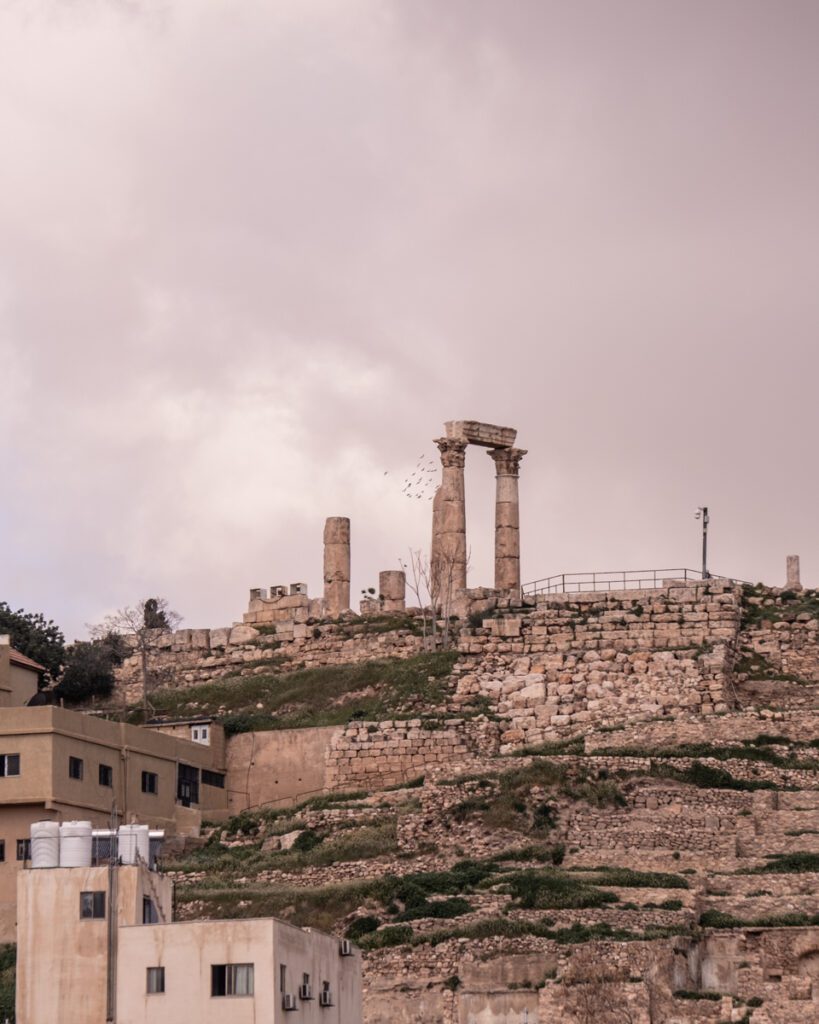
From Amman to Petra
If you are in Amman, the drive to Petra will take about 3 hours. There are a few different ways to get there. Here are some quick tips about each option you have. We’ll dig deeper into the Amman to Petra drive in a different article.
- Getting to Petra by rental car. If you’re planning a road trip around Jordan, which we highly recommend, then the easiest and best way to get to Petra from Amman is to drive there with your rental car. You’ll be taking the Desert highway from Amman to the town of Wadi Musa.
- Taking a Jett Bus from Amman. There is a bus that leaves Amman (Abdali or 7th Circle) every day and that will get you to Petra. The buses depart at 6:30 am or 7 am. If you’re not renting a car in Jordan, this is your cheapest and best option at 10 JOD per person. Check the latest schedule & pricing here.
- Take a guided tour from Amman to Petra. Although we don’t recommend taking a day trip from Amman to Petra, there are multi-day guided tours that will take you around Jordan. If you have the budget and want to make friends along your journey, this is a great option for you.
- Take a taxi to Petra. This is the most expensive option, but might be the most hassle-free choice. From the Amman Airport, you can take a taxi to Petra for about 80 JOD. If you’re planning on visiting Amman, you can ask your accommodations to book a taxi for you, or give you the contact info of a reliable driver. This ride should cost about 80-100 JOD. If you’re a larger group, you can use this reliable service from Viator.
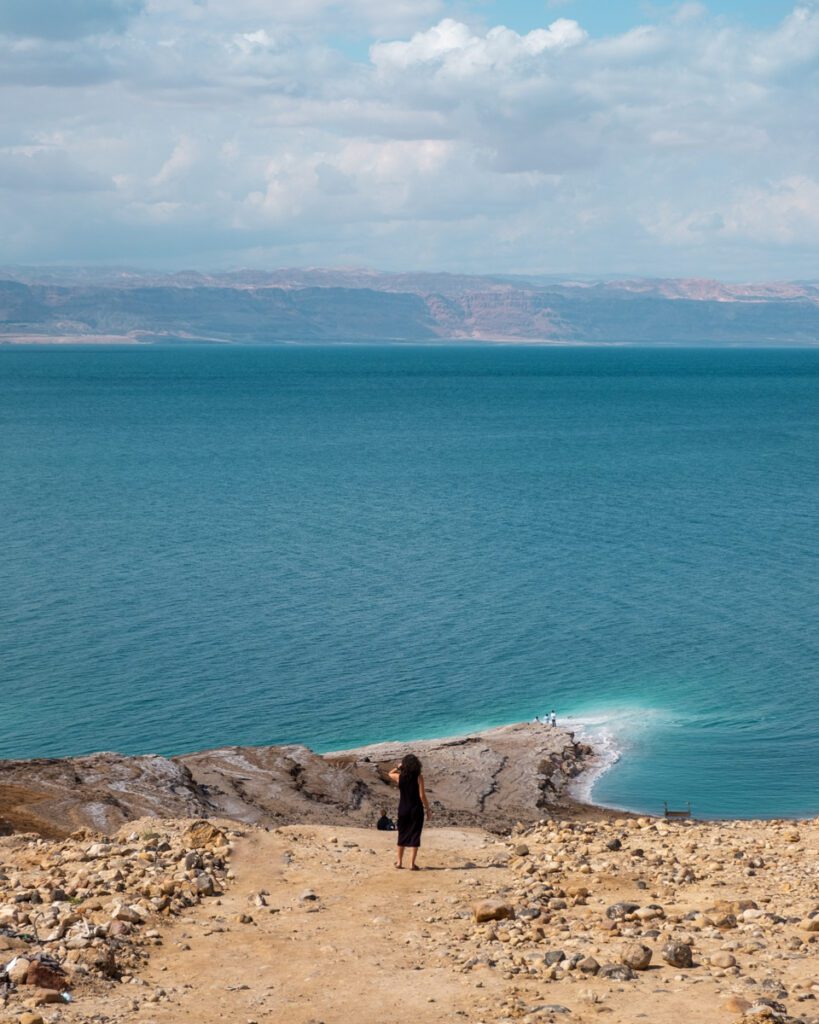
Getting from the Dead Sea to Petra
From the Dead Sea, your journey to Petra will take a little over 3 hours. You can either drive here in your rental car or take a private transfer. Jett bus does not have service from the Dead Sea to Petra at the time of writing.
Make sure you read our full guide to the Dead Sea while planning your Jordan trip.
- Take your own rental car. Once you have your rental car, from the Dead Sea to Petra, you’ll drive down the Dead Sea Highway and the Tafileh highways – both are scenic and amazing. Make sure you read our guide to driving in Jordan to be fully ready.
- Take a private transfer from the Dead Sea. You can arrange to have a driver take you from the Dead Sea to Petra. We found this well-priced and highly-rated service on Viator. Let us know in the comments if you find a better one.
Note that along this route, you’ll be able to see some of the famous salt patches on the shores of the Dead Sea.
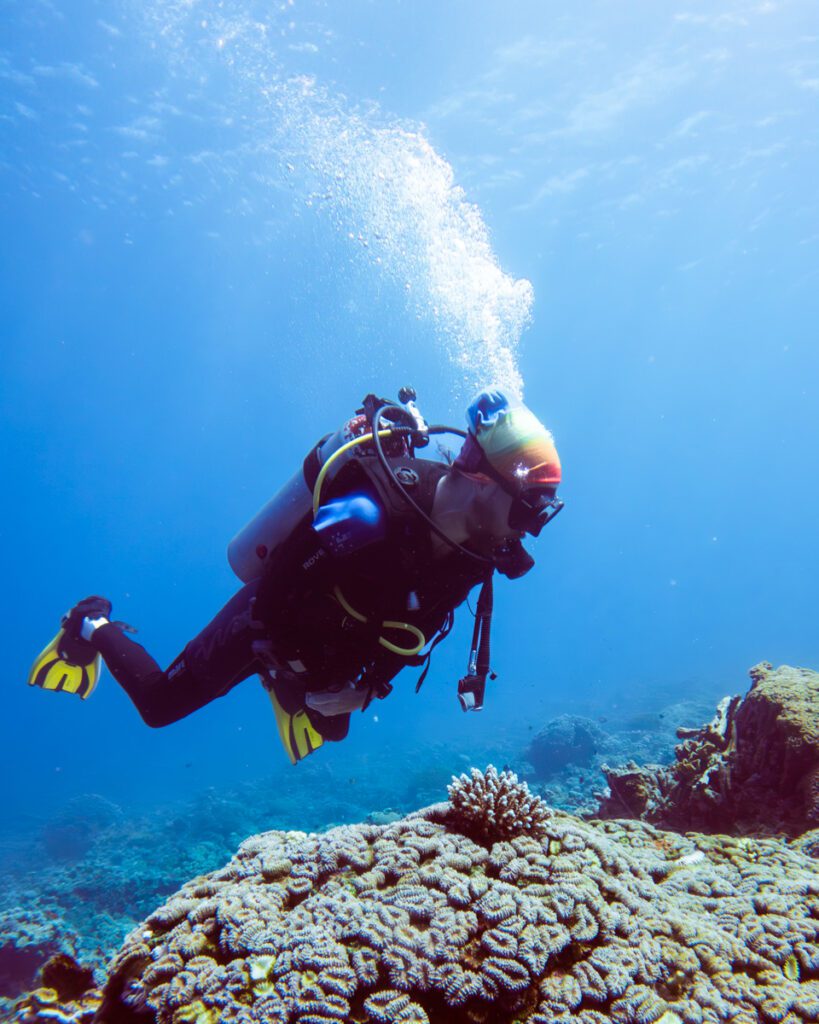
Aqaba to Petra
If you plan on going scuba diving or beach lounging in Aqaba, you have a few different ways to get to Petra from there. You can take your own rental car, take a private shuttle or hop on a Jett Bus.
- Take your rental car. From Aqaba, the drive to Petra is a short one, at less than 2 hours. The ride is smooth and very pleasant as you’ll be driving in the mountains pretty much the whole way through. To us, renting a car in Jordan is the best way to get around.
- Take a Jett Bus. For 15 JOD, you can hop on the Jett bus that leaves Aqaba daily at 8 am. You’ll be there before lunch and have a good half-day to start exploring the highlights of Petra. Check the latest schedule & pricing here.
- Take a private transfer. From Aqaba, you can take a private transfer to Petra. They will pick you up from your accommodations and take you to your hotel in Petra. We found this highly-rated and well-priced option for you.
Please note that if you plan on scuba diving in Jordan, make sure you don’t dive the day you are leaving to head to Petra. Aqaba is located at a lower altitude level than Petra. Diving on the day you’re leaving may cause you to get decompression sickness.
Wadi Rum to Petra
Wadi Rum is an amazing place to visit. Surely one of the highlights in Jordan. The journey from Wadi Rum to Petra will take a little less than 2 hours. You can take your own car there, take a Jett Bus or a private transfer. Here is how to plan your journey.
- Take a rental car. From Wadi Rum, you’ll get to Petra by taking the Desert Highway. It’s a smooth ride that takes you from the desert to the high mountains around Wadi Musa. Please be careful driving near Petra – on our way back, we had crazy thick fog and the visibility was extremely poor. Make sure to read our guide to driving in Jordan.
- Take a bus to Petra. From the Wadi Rum Village, at the Visitor Centre, Jett Bus has daily service to Petra. This will cost you 15 JOD. The bus leaves at 10 am every day. Check the latest schedule & pricing here.
- Use a private transfer service. There are plenty of drivers that will take you from Wadi Rum to Petra. Here is a great option we found for you with great reviews and well-priced (especially if you’re a group).
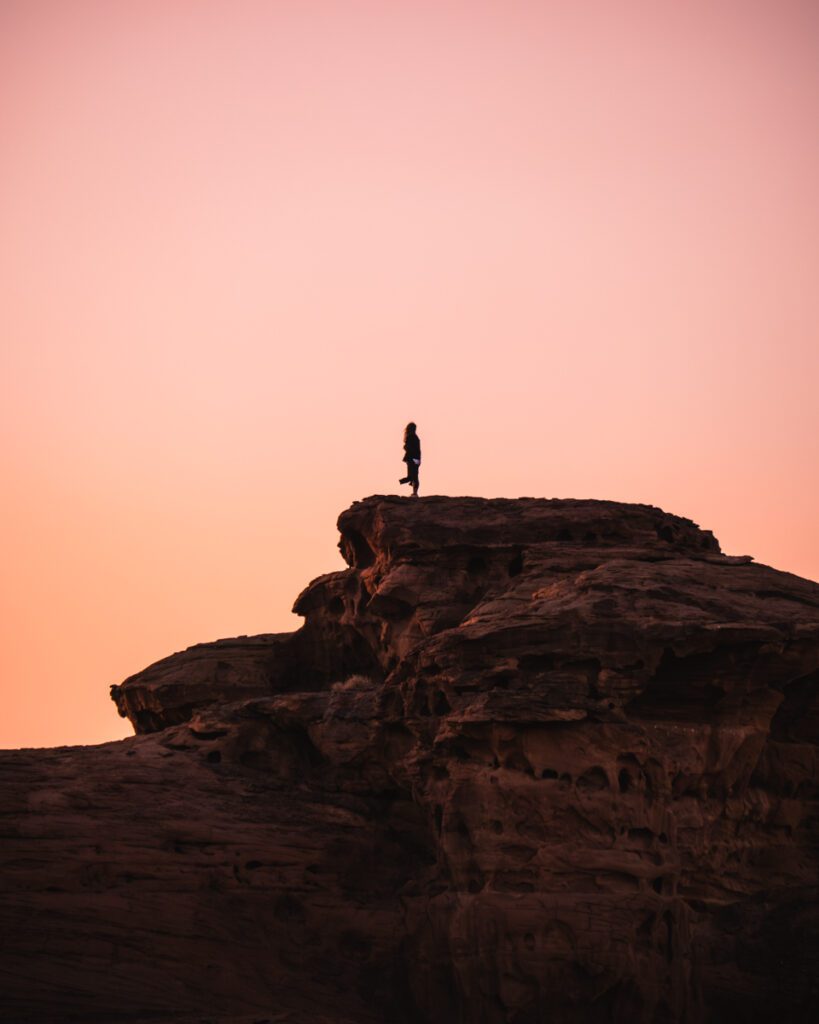
Dana Valley to Petra
The Dana Valley is one of our favorite places in the country. It’s truly a hidden gem in Jordan. This means that you won’t have many options to get from the Dana Valley to Petra. Your best bests are to have your own rental car or to plan a private transfer.
- Drive your car to Petra. The drive from the Dana Valley to Petra is a short one, about 1 hour. The route is incredibly scenic, all in the mountains. Again, be careful with visibility as weather patterns can be unpredictable in this part of the country. Make sure you read our guide to get a good understanding of what to expect.
- Use a private transfer service. As we mentioned, there aren’t too many options to get from the Dana Valley to Petra. Here is a great option we found for you with great reviews and well-priced (especially if you’re a group). They offer pick-up and drop-off in many places in Jordan.
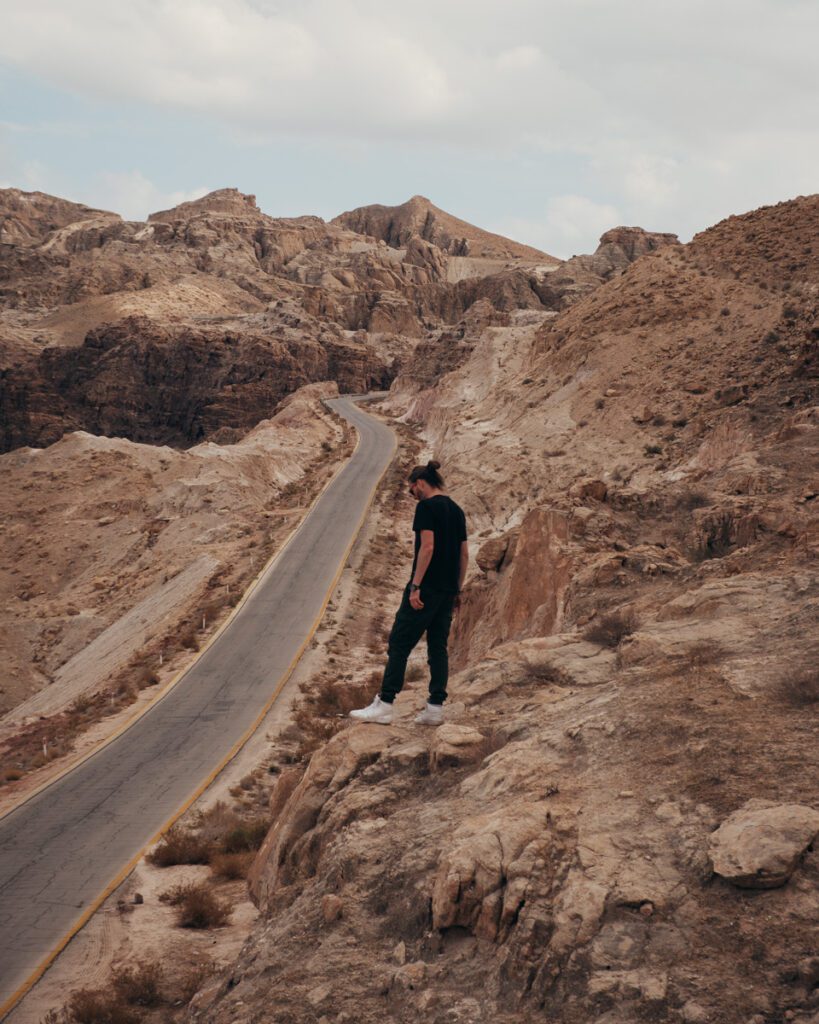
How to get around Petra
When booking your accommodations in Petra, we recommend staying as close to Petra as possible. This will allow you to simply walk around without having to use your car.
We stayed at the Petra Corner Hotel and didn’t take the car for the entirety of our stay in Wadi Musa. We walked from the hotel to Petra and from the hotel to nearby restaurants.
Some hotels will offer bikes to get from there to Petra. Others even have shuttles that also get you to the site.
Where to eat in Wadi Musa
We’ll be honest, we didn’t eat in too many different places in Wadi Musa. The reason was simple – we found a really great place and went back 2 times! Also, being vegan, the choices were sometimes limited.
For breakfast, we opted for a hotel that served it in the morning. We had 2 different experiences at the Petra Corner Hotel. One day, they served us a set menu of eggs, cheese, meats, bread, hummus and veggies. The next day, we had a huge buffet set up with plenty more options.
For lunch, we opted to grab snacks at a grocery store and brought them into Petra with us. This was a great budget-friendly way to ensure we had vegan options and to get exactly what we wanted.
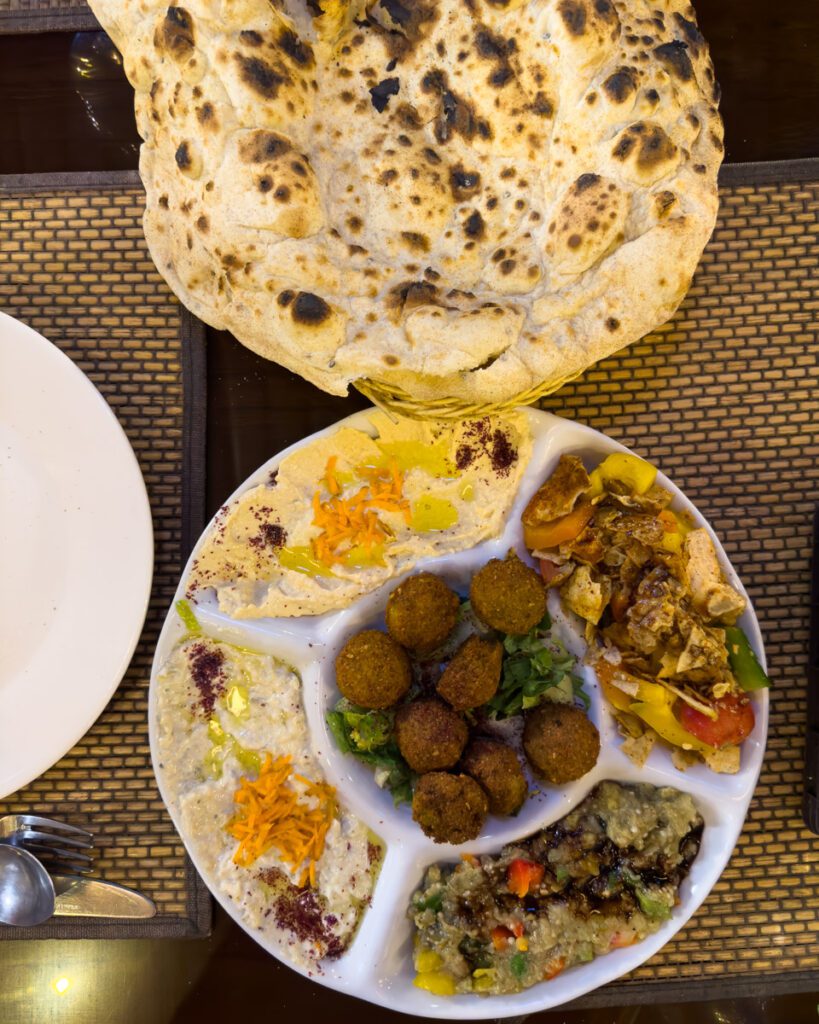
For supper, we went back, over and over, to Falafel Time. It was right by our hotel, and in the rainy season, we didn’t want to walk too far. Plus, the service was friendly, the food was exquisite and the portions were quite generous. Derek had a shawarma sandwich on one day, and he loved Carine’s Falafel plate so much, he had that on the second day. Carine stuck to the falafel plate or sandwich. We also got some hummus to go with the freshly made bread. We enjoyed a lentil soup on a colder day. And topped everything off with some baklava, which was vegan! Everything was beyond delicious!
We also stopped by Al-Qaysar Cafe on one of the days we got hungry. They had some great options of local dishes and everything was well-priced. The food was quite tasty, although when we visited, in the afternoon, they didn’t have all their options available. They also had limited choices of vegan options. But for a quick bite, this was great!
Exploring the Ancient City of Petra
We hope that our full guide to visiting Petra, the Rose City, was helpful to you. We tried to cover as much as possible to help you plan your trip.
If we forgot anything, or if you have any other questions, please feel free to leave us a comment. We’d be happy to answer you as quickly as possible.
Also, let us know in the comments what you’re most excited to see in Petra.
Thank you so much for reading the article all the way through!
We put a lot of time and effort into the content we create. Please like, comment and share – every action on your part helps us out tremendously and is very appreciated.
You can also help us by pinning this article for others to find.

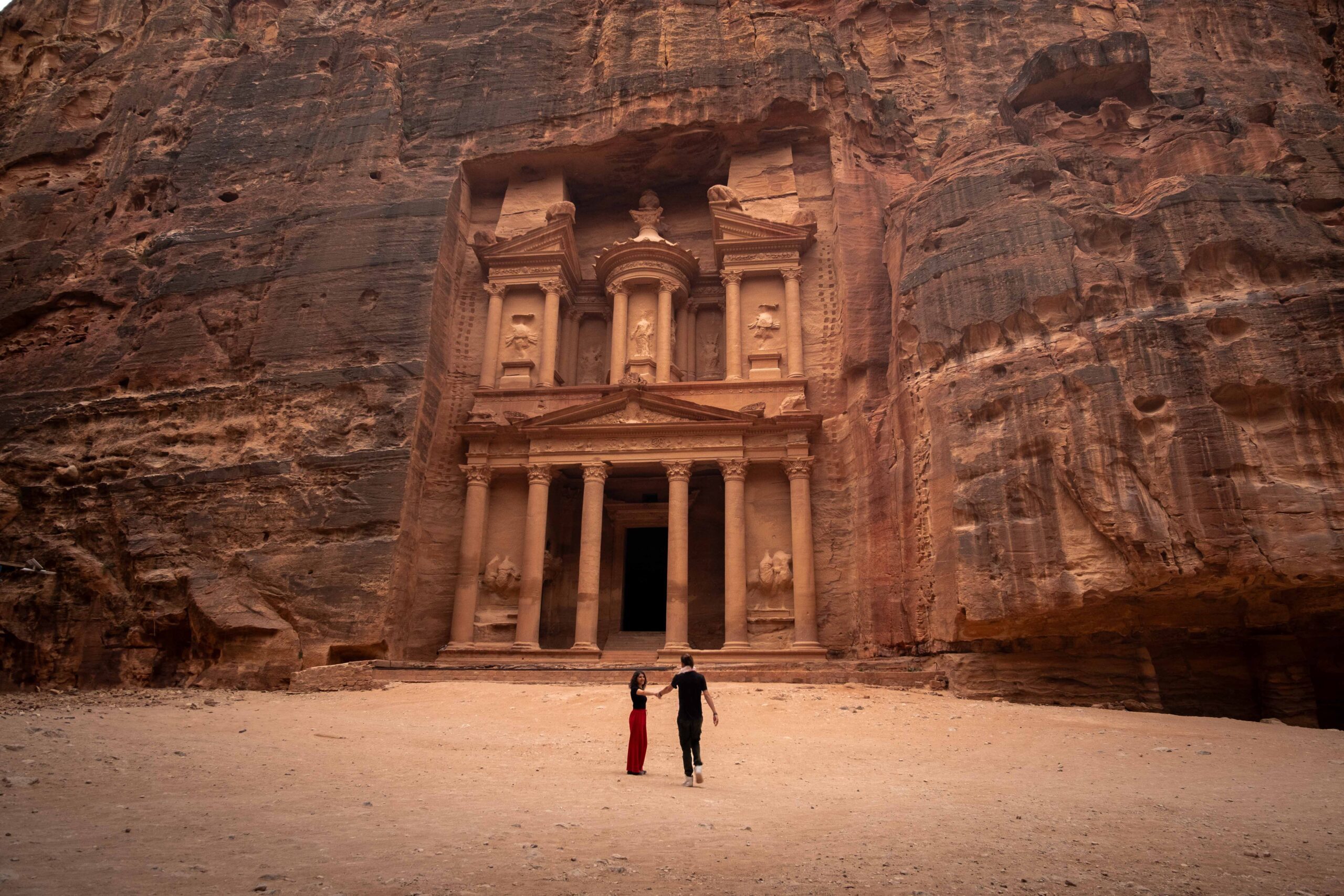
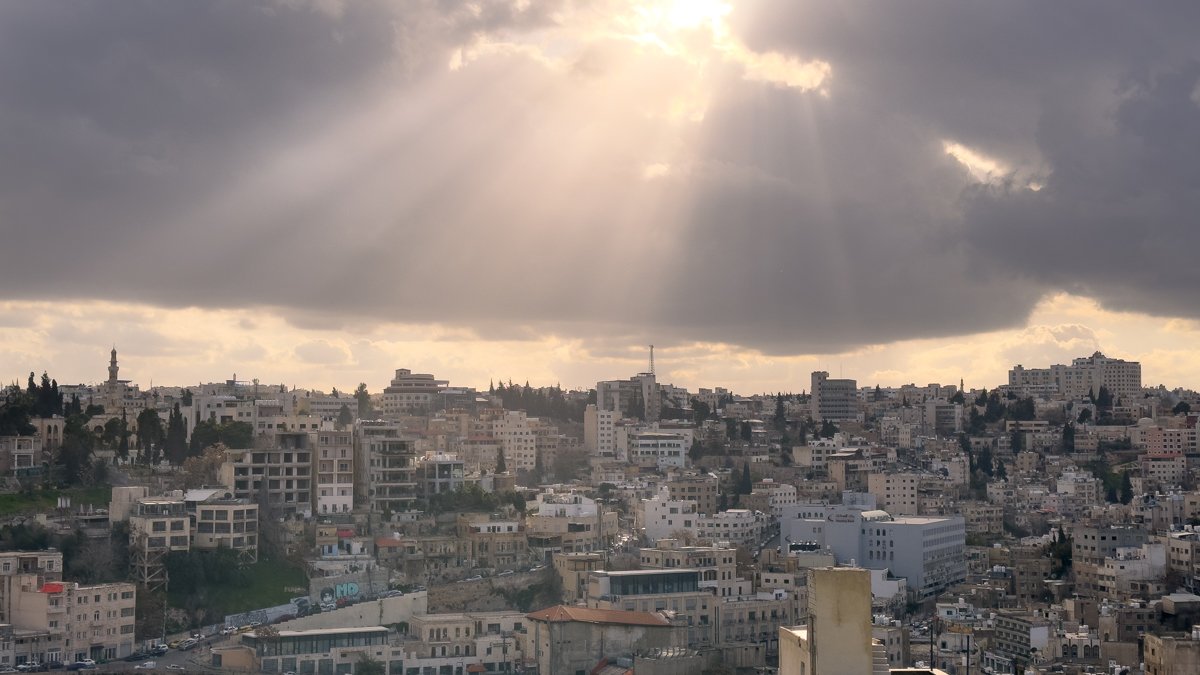
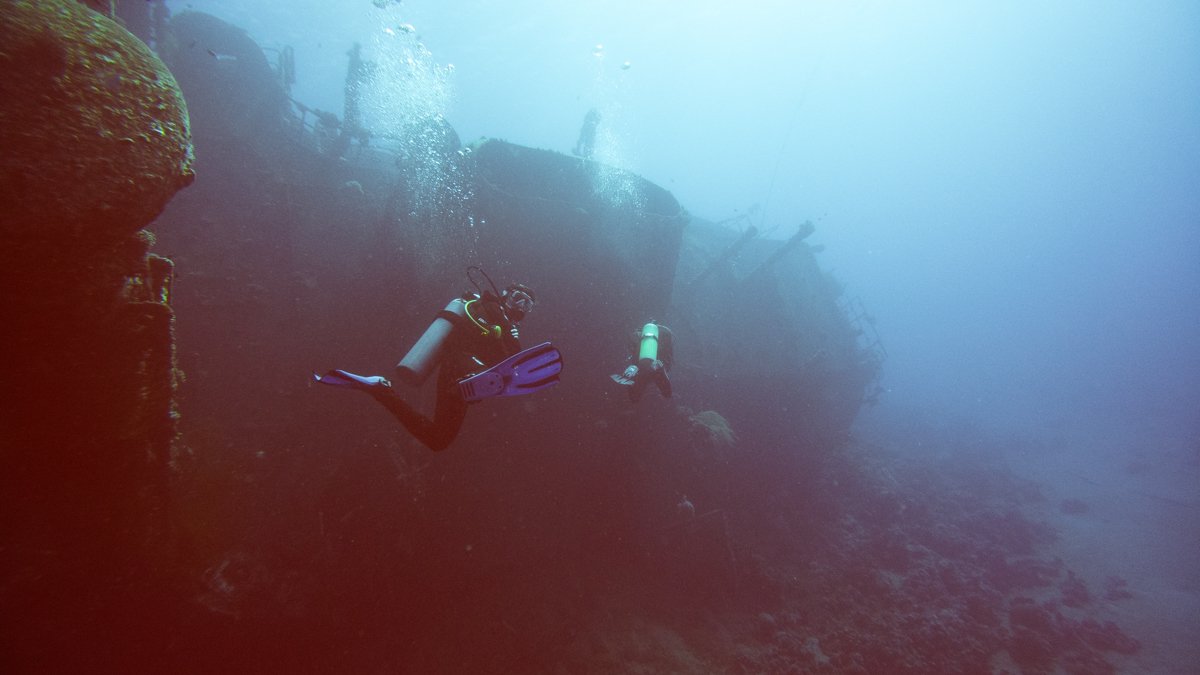
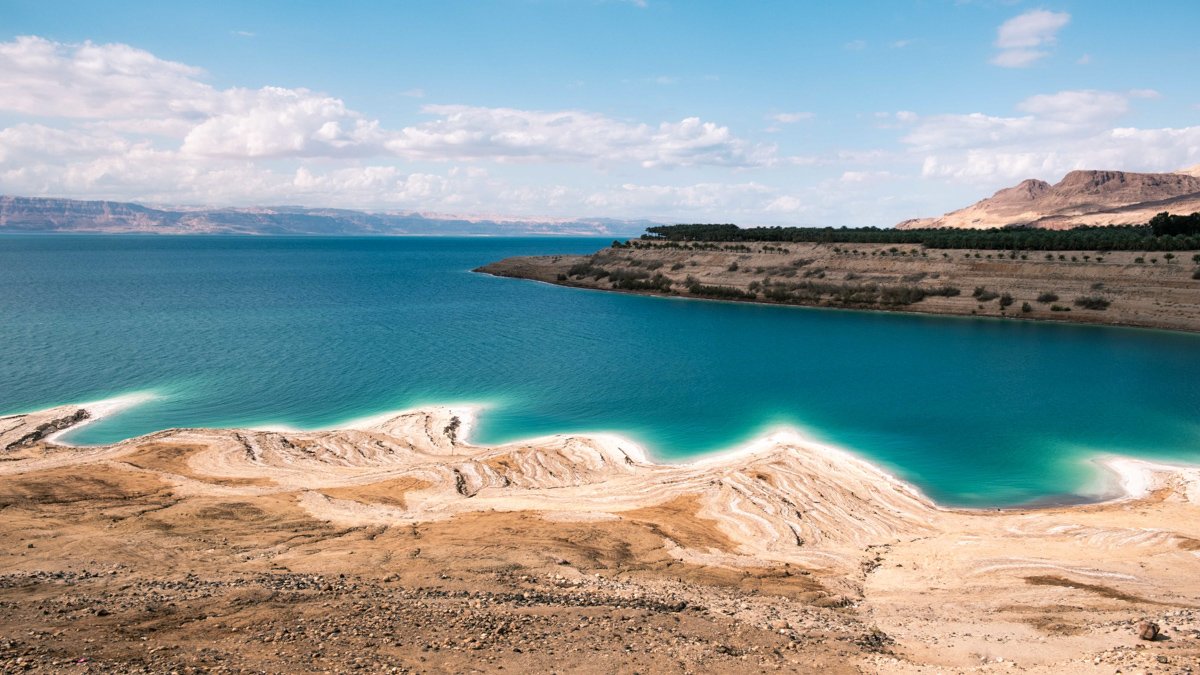
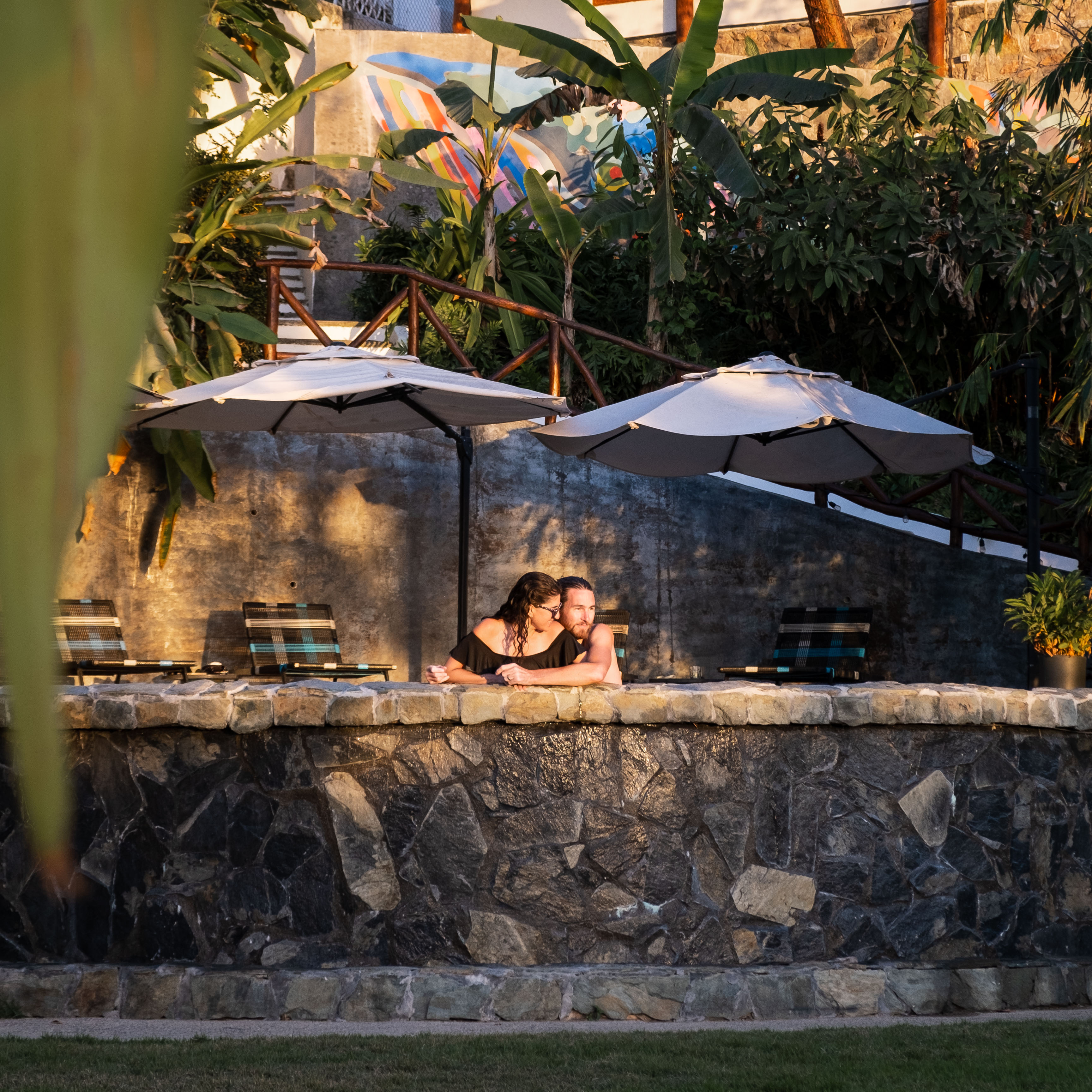


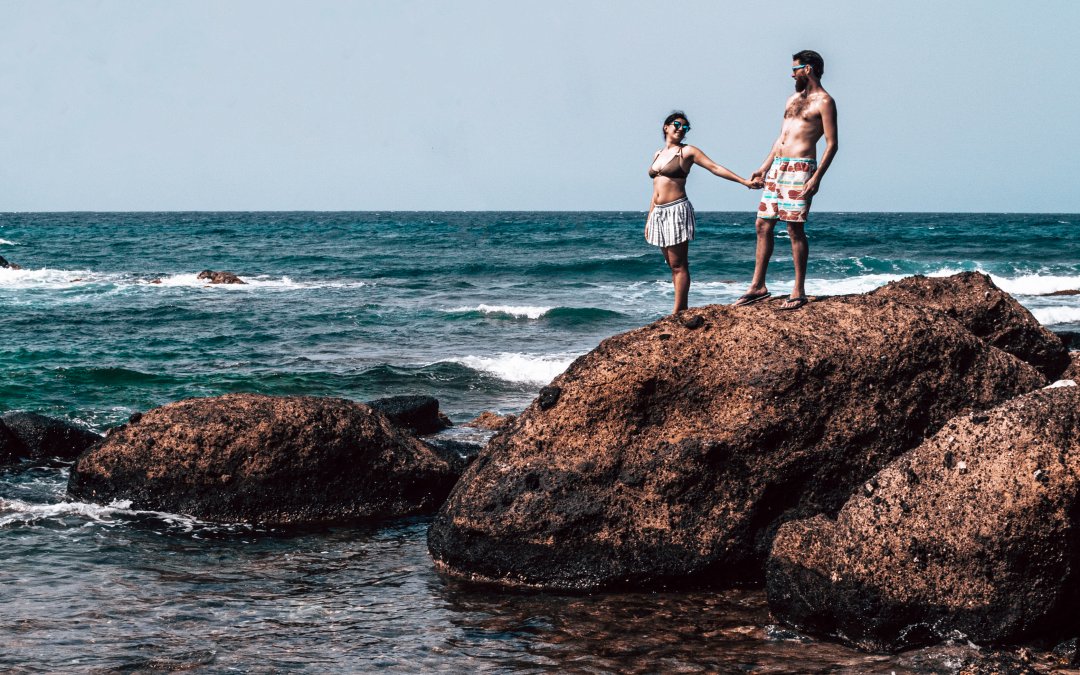
0 Comments